

Sonar search for missing Jones comes up empty

TRAVIS SNELL
CTUIR Communications
MISSION – A sonar search on the first weekend of November along the Umatilla River on the Umatilla Indian Reservation yielded no results in the case of missing Confederated Tribes of the Umatilla Indian Reservation (CTUIR) member Wesley Dixon Jones.
Just days prior, the Umatilla Tribal Police Department (UTPD) and FBI marked deeper areas of the Umatilla River to prepare for the sonar search by the MMIW Search & Hope Alliance
UTPD Det. William Morris said he, an FBI agent and a CTUIR
Department of Natural Resources employee walked the river on Oct. 29 from Nicktyoway Road to the Highway 331 bridge on the Umatilla Indian Reservation (UIR) using a GIS application to mark deep pools of water so a sonar machine can be used to search for Jones.
Morris said MMIW Search & Hope Alliance brought several volunteers along with a sonar called the AquaEye.
“It is a sonar device that can scan underwater, and so they’re going to be going along the river in the area where Mr. Jones went missing and trying to scan, especially deep
Brigham wins BOT chair, 5 incumbents retain seats
BY THE CUJ
MISSION – On Tuesday, Nov. 4, Confederated Tribes of the Umatilla Indian Reservation (CTUIR) voters retained five incumbents and elected six new members to the Board of Trustees (BOT) and General Council to lead the CTUIR for the next two years.
For the BOT, the CTUIR’s governing body, voters elected N. Kathryn Brigham to replace Gary I. Burke as chair. For vice chair, incumbent Aaron Ashley
retained his seat. Also retaining his seat was Treasurer Raymond Huesties. However, incumbent Roberta J. Wilson was defeated by Monica Paradise for the secretary position.
Three incumbent BOT members at large retained their seats: Toby Patrick, Corinne Sams and Lisa Ganuelas. However, incumbent Steven Hart lost his seat to Sierra Quaempts.
Lindsey X. Watchman was elected the new General Council chairman, defeating incumbent

Alan Crawford. Boots Pond defeated incumbent Michael Ray Johnson for the General Council vice chair, and Shawna Gavin won the General Council secretary race easily defeating write-in candidates.
As for General Council interpreter, incumbent Thomas Morning Owl will retain his seat as a holdover until a new interpreter is elected. The CTUIR Election Commission issued a statement on Nov. 4 saying because it did not receive any nominating petitions
from candidates it subsequently did not catch the missing writein line until after the absentee ballots were mailed. Therefore, no write-in line for the seat was on the ballot. According to the CTUIR Constitution, the Election Commission will establish a separate voting process for all General Council members to vote for the interpreter position.
Voters also passed a referendum question to allow alcohol sales
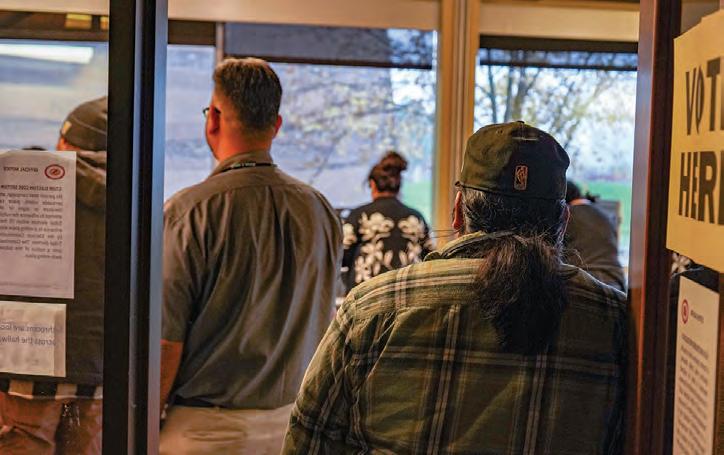

Department of Natural Resources Fisheries Manager Jerimiah Bonifer leads Umatilla Tribal Police Department Det. William Morris and FBI Special Agent Megan Sharp along the Umatilla River on Oct. 29. TRAVIS SNELL/CTUIR
Voters sign in to get their ballots for the Confederated Tribes of the Umatilla Tribes of Indian Reservation's Nov. 4 general election at the Nixyáawii Governance Center. PHOTOS BY LEE GAVIN/CTUIR
Voters wait their turns to get their ballots on Nov. 4 at the Nixyáawii Governance Center. Registered voters selected Board of Trustees and General Council officials for the next two years as well as voted on a referendum question.

ABOUT THE CUJ
The Confederated Umatilla Journal (CUJ) was created in 1975 as the official publication of the Confederated Tribes of the Umatilla Indian Reservation (CTUIR), which includes the Cayuse, Umatilla and Walla Walla people. The CUJ is produced monthly by the CTUIR Communications Department.
Publisher: Kaeleen McGuire kaeleenmcguire@ctuir.org
Editor: Vacant
Reporter: Vacant
Advertising: M. Moses-Conner cuj@ctuir.org
Contributors:
Kathy Aney
Dallas Dick
Annie Fowler
Lee Gavin
Sammantha McCloud
Wil Phinney
Travis Snell
Aaron Worden
CONTACT US
Confederated Umatilla Journal 46411 Timine Way Pendleton, OR 97801
Email: CUJ@ctuir.org Phone: 541-429-7005
EMAIL ADVERTISING, LETTERS TO THE EDITOR & OTHER SUBMISSIONS TO: CUJ@ctuir.org
DEADLINE: 20th of the month prior to publication
The CUJ prints on the first Wednesday of each month and is distributed the first Thursday.
SUBSCRIBE
The CUJ is free to pick up at tribal entities and area businesses. However, a mailed subscription can be purchased for the price of shipping and handling by contacting the CTUIR Finance Department. Call 541-429-7150 or visit the Finance Department in person at Nixyáawii Governance Center, 46411 Timine Way, Pendleton.
One year: $15 • Two years: $28
For more information or daily news, visit the CUJ online at: www.TheCUJ.org
CTUIR Board of Trustees responds to federal shutdown’s SNAP impact
The Board approves $200,000 to help those tribal members who were already SNAP-enrolled through November.
BY THE CUJ
MISSION – The Confederated Tribes of the Umatilla Indian Reservation (CTUIR) Board of Trustees (BOT) on Oct. 31 approved $200,000 for tribal members who would be affected by the loss of Supplemental Nutrition Assistance Program (SNAP) funding due to the federal government shutdown.
The BOT approved the emergency dollars to make up for the loss of SNAP in November.
According to the U.S. Department of Agriculture (USDA) no SNAP benefits would be issued in November as the government has yet to agree on funding allocations for fiscal year 2026.
To receive the CTUIR funds, tribal members who are currently enrolled in SNAP can apply from 8 a.m. to 3:30 p.m. on Monday, Nov. 3 to Thursday, Nov. 6 at the Department of Children and Family Services (DCFS) in the Nixyáawii Governance Center. Tribal members, especially
ELECTION
at Arrowhead Travel Plaza by a 54.45% to 45.55% split. Alcohol sales will be limited to beer, wine, hard seltzer and hard cider and only for off-site consumption.
The elected officials take office Dec. 3 in a 9 a.m. inauguration ceremony at the Nixyáawii Governance Center. The public is invited to attend.
Following are the unofficial election results showing the number of votes received.
A total of 819 votes were cast. The winners are identified in bold. The certified results will be completed in accordance with the CTUIR Election Code.
BOT
those who cannot visit DCFS, can also call 541-429-7300 or email ChildrenFamilyServices@ctuir. org for applications.
Needed documents for verification purposes are:
• CTUIR tribal ID card or stateissued ID card,
• Birthdate,
• Social Security number,
• SNAP benefit letter confirming enrollment,
• Release of Information (ROI) from Department of Human Services and, if needed,
• Updated Enrollment Address Change form.
The aid is not taxable as it stems from a temporary general welfare assistance program.
The Oregon Department of Human Services (ODHS) has stated SNAP electronic benefit transfer or EBT cards should work normally during the shutdown for clients who have funds in their SNAP accounts.
According to the ODHS, 462 CTUIR members in the state use the program.
More than 1 million American Indian/Alaska Natives and 42 million Americans overall could be affected by the SNAP cutoff,
“We also recommend clients to keep their SNAP enrollments open and to not close them because of the difficulty of getting into the program.”
“We in DCFS encourage the tribal members who are already enrolled in SNAP to please have your documents in order when applying to make things run smoothly,” DCFS Director Julie Taylor said. “We also recommend clients to keep their SNAP enrollments open and to not close them because of the difficulty of getting into the program.”
Checks will be mailed out each Friday to the addresses clients have on file with CTUIR Enrollment.
according to the USDA.
A federal judge ruled Oct. 31 that the Trump administration cannot suspend SNAP benefits as it would likely violate federal law.
However, the judge did not issue a full restraining order and directed the USDA to report back by Nov. 3 on whether it will issue at least reduced SNAP benefits for November and to outline whether it plans to use contingency funds or combine them with other funds to provide full benefits.
BOT
Roberta J. Wilson
BOT
Corinne

Registered voters of the Confederated Tribes of the Umatilla Indian Reservation on Nov. 4 chose to sale limited alcohol products at Arrowhead Travel Plaza. By a 54.55% majority of the vote, tribal members chose to have beer, wine, hard seltzer and hard cider sold at the plaza for off-site consumption. FILE
pockets of water that we can’t just visually inspect,” he said.
AquaEye Pro sends a sonar pulse into water, echoing off objects. The echoes bounce back to the device, which determines if the echoes match those that would be made by a human body. It then provides the location and distance of the suspected body in the water.
Jones, 71, was last seen more than a month ago on camera at approximately 3:15 p.m. on Oct. 5 along east Short Mile Road in a gray 2003 Ford Escape with Oregon license plate SM15454. Morris said when the vehicle returned west on the same road Jones was no longer visible in it. Morris said he could not disclose the driver’s identity because of the investigation.
Jones is described as a 5-feet, 8-inch-tall Native American weighing approximately 140 pounds with long black hair and brown eyes. He was last seen wearing a black and red Tiger Scott jacket, black shirt, black sweatpants and boots.
The UTPD has also previously requested the public to provide video footage of the area in which Jones is suspected of going missing on Oct. 5.
“So we are looking for video footage, especially from roadfacing cameras, anywhere between Cayuse Road and Bingham Road or from Short Mile Road over to Cayuse Road, including River Road,” Morris said. “And what we’re looking for is any video footage that shows that Ford Escape driving by or a
similar vehicle.”
To upload video, visit https:// umatillatribalpd.evidence.com/ axon/community-request/public/ wes-jones or call the UTPD at 541278-0550 or Morris at 541-969-7139.
Morris added that he wanted to clarify two pieces of misinformation associated with the investigation. The first is the rumor that the gray 2003 Ford Escape was not the vehicle Jones was last seen in because it had a flat tire. Morris said it is the vehicle contrary to rumor.
“That vehicle sustained a flat tire at some point the day that Mr. Jones went missing and they continued driving on that vehicle with a flat tire,” he said.
The other misconception deals with Jones supposedly being seen at Arrowhead Travel Plaza the night of his disappearance.
“I can say we did look into that lead, and we can say that he was not at Arrowhead Travel Plaza that night,” Morris said.
Along with searching the river with the AquaPro, Morris said MMIW was expected to bring at least one dog for a search potentially east of Sampson Road, which is further upriver.
Since Oct. 6, the UTPD has conducted two searches with the Umatilla County Sheriff’s Office Search & Rescue using canines, three aerial drone searches over parts of the Umatilla River and two searches on foot.
Jones’s family has also conducted searches. Morris said although the UTPD was not directly associated with those searches the family is keeping him informed.
Anyone with information can call the UTPD at 541-278-0550.




We have dozens of jobs open, including:
Pendleton: Tier 1.0 Helpdesk Specialist
BIE Desktop Technicians: Belcourt, ND & Crownpoint, NM
Remote: Service Desk Agent
CTUIR Enrolled Members, please email jobs@cayusess.com and indicate you are a CTUIR citizen to be considered for current and upcoming jobs.

Selena Pasillas HR Generalist Support Team
Allyson Fairweather Proposal Coordinator Government Team
Daniel Aab Senior Service Desk Agent Commercial Team
FBI Special Agent Megan Sharp, Umatilla Tribal Police Department Det. William Morris and Department of Natural Resources Fisheries Manager Jerimiah Bonifer get read to walk the Umatilla River on Oct. 29 to mark spots for a sonar search.
Arrowhead adds electric vehicle charging stations
DANELI ATILANO CUJ
MISSION — Electric vehicle drivers traveling Interstate 84 now have access to a first-of-its-kind charging experience in Eastern Oregon.
A new installation at Arrowhead Travel Plaza, adjacent to Wildhorse Resort & Casino, features four dual-dispenser GridLink chargers powered by both solar energy and battery storage.
The site, which is the first solarplus-storage DC fast-charging station in the state, was developed through a partnership between XCharge North America and Wildhorse Resort & Casino.
NetZero Energy, LLC, played a key role by identifying the opportunity and managing the project, including due diligence, system design and implementation.
Located on the Confederated Tribes of the Umatilla Indian Reservation, the Arrowhead Travel Plaza sees traffic from more than 1.7 million vehicles annually.
The new chargers are expected to serve growing demand for EV infrastructure in the region, especially for drivers facing the steep and weather-prone Cabbage Hill route on I-84.
“We partnered with XCharge NA because they provide a gridfriendly charging solution with battery storage that seamlessly integrates with a custom solar canopy — a perfect fit for our

climate,” said Tom Fine, general manager of Arrowhead Travel Plaza. “Their technology provides clear operational and economic advantages that assist Arrowhead Travel Plaza in providing a needed service for the broadening customer base.”
The system includes four 215-kilowatt-hour GridLink units integrated with 40 kilowatts of solar.
Each unit can deliver up to 194 kilowatts of power, offering a fast and reliable charge for nearly all EV models.
“This project supports the Tribe’s dedication to sustainable
practices and our mission to deliver a forward-thinking experience for all guests and travelers,” said Gary E. George, chief executive officer at Wildhorse Resort & Casino.
The deployment expands XCharge North America’s footprint to 18 states and marks a milestone in combining clean energy with high-speed EV charging.
“Helping create Oregon’s first solar-supplemented DC fastcharging site marks a major milestone in XCharge’s journey of innovation and sustainability,” said Aatish Patel, co-founder and president of XCharge NA.
“Our Arrowhead Travel Plaza
installation goes beyond simply delivering ultra-fast charging. It’s a powerful demonstration of how integrating our GridLink technology with solar power can offset grid demand, enhance a charging site’s resilience and flexibility, and even bolster the region’s energy architecture.” GridLink technology includes advanced bidirectional charging, off-grid capabilities in emergencies, integration with photovoltaic systems and enhanced safety features such as thermal runaway sensors and built-in fire suppression.
COLUMBIA RIVER INTER-TRIBAL FISH COMMISSION


CRITFC Main Office
(based in Portland, OR)
• Manager, Policy Developement and Litigation Support Dept • $156-180K annual
• Executive Assistant • $67-87K annual
Law Enforcement Positions
(based in Hood River, OR)
• Police Officer • $32-38 per hour
Arrowhead Travel Plaza has installed new electric vehicle chargers that are powered by solar energy and battery storage. WILDHORSE RESORT & CASINO
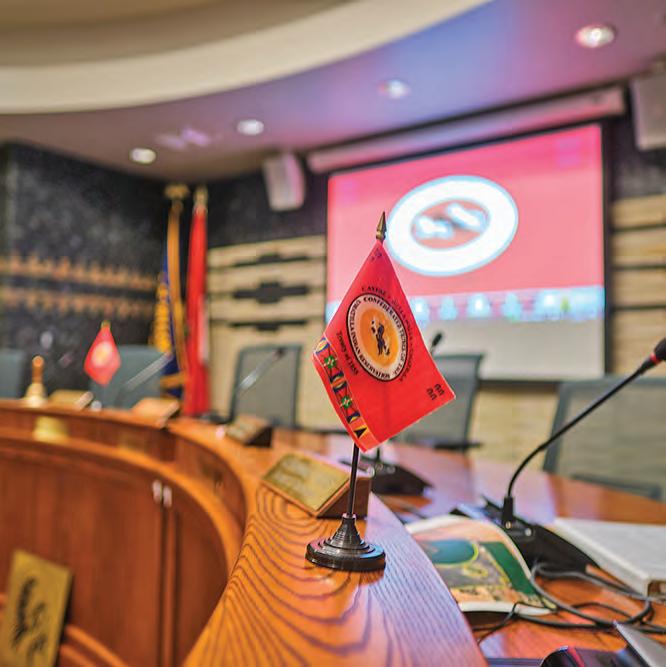
BOT to approve FY 2026 budget in November
RAYMOND HUESTIES
Treasurer
MISSION – The 2026 budget for the Confederated Tribes of the Umatilla Indian Reservation (CTUIR) is under development. The draft budget was presented at the Oct. 30 General Council meeting. The Board of Trustees (BOT) conducted work sessions in October to review the target budgets and draft annual work plans from the departments and enterprises.
Based on the current projected revenues the 2026 draft budget presented to General Council in October, the budget includes an increase in salaries of 4% for cost of living adjustment (COLA) and merit increases, an 8.04% increase in fringe, reducing travel and supply line items by 10% and maintaining all other triballyfunded government services at their existing 2025 levels while also striving to maintain levels of service to the community.
The CTUIR uses a retrobudgeting process for its gaming funds, meaning that the money

earned in one calendar year is used to fund CTUIR programs in the following year. For example, funds earned in 2025 are spent in 2026.
CTUIR Treasurer Raymond Huesties said the retro-budgeting process helps the CTUIR because it allows the BOT to make budget and spending adjustments in the following year, not in the current year.
The draft 2026 budget was expected to be available to General Council members at the Oct. 30 General Council meeting. To obtain a copy after the meeting, call the Finance Department at 541-429-7150.
Comments on the draft budget can be submitted in writing or by email to Treasurer Huesties by Nov. 6. at RaymondHuesties@ ctuir.org. The BOT anticipates adopting the budget at the Nov. 10 meeting, Huesties said.



The Board of Trustees are set to approve the CTUIR 2026 budget in November. FILE
Raymond Huesties
Perry
confirmed to Oregon Energy Facility Siting Council
BY THE CUJ
MISSION
– Patty Perry,
the Planning Department director for the Confederated Tribes of the Umatilla Indian Reservation (CTUIR), has been confirmed to fill a vacant position on the Oregon Department of Energy’s Energy Facility Siting Council.
The council, with its seven members appointed by the governor and confirmed by the state Senate, oversees the development of electricgenerating facilities, high-voltage transmission lines, gas pipelines, radioactive waste disposal sites and other projects. Proposed facilities must meet standards to receive site certificates. The council also has regulatory authority over a facility’s construction and operation.
Perry, who is on the CTUIR Energy Strategy Team, said her teammates recommended her to the CTUIR Board of Trustees (BOT) as a candidate to fill the council vacancy.
“The BOT wrote a letter to the governor recommending me for the position. I agreed and submitted my qualifications to the governor’s office and was referred to the Senate Rules Committee for a hearing,” she said. “I attended the scheduled hearing on Sept. 29 and submitted testimony to the committee, which recommended my appointment to the full Senate following its vetting. The Senate voted and confirmed my appointment on Sept. 30.”
Her council term runs from Oct. 1, 2025, to June 30, 2029.
Although feeling a bit overwhelmed upon learning of her confirmation, Perry said she is confident she can do the job.
“It started sinking in when I was sent a bunch of forms to fill out, received the council hearings schedule for the rest of the year and a lot of information about energy projects to absorb and review,” she said. “I will have an additional workload, which has already started, but I know I can handle it. I also greatly appreciate the support of the CTUIR Board of Trustees and Office of Executive Director and the confidence in me they have demonstrated by recommending me for the position.”
Perry said even though she won’t be representing the CTUIR on the council, the knowledge she’s learned while working for the tribal government could help with her decisions.
“As a long-time tribal planner with experience and knowledge of treaty rights, tribal sovereignty, working with various land jurisdictional issues, and with the cultural education I have received while working here at CTUIR for 18 years, I hope to be able to apply those insights learned while reviewing these projects,” Perry said.
WSU team unlocks biological process behind coho salmon die-offs
SHAWN VESTAL WSU News & Media Relations
For years, scientists at Washington State University’s (WSU) Puyallup Research & Extension Center have been working to untangle a mystery: Why do coho salmon in Puget Sound creeks seem to suffocate after rainstorms — rising to the surface, gaping and swimming in circles before dying?
In 2018, the die-offs were linked to bits of car tires shed by friction and washed into the stormwater runoff. In 2020, researchers zeroed in on a tire preservative known as 6PPD.
Now, research led by WSU Ph.D. student Stephanie I. Blair has established the biological mechanism for how that toxin kills the fish, laying the groundwork for tests to find an alternative.
When 6PPD interacts with ozone, it becomes a toxic chemical known as 6PPD-quinone. Blair, working with a team from WSU and the University of Washington, demonstrated that 6PPD-quinone breaches the cellular walls that protect the brain and vascular system, known as the blood-brain barrier and the blood-gill barrier, causing oxygen deprivation.
“Prior to publication of this study nobody really knew what the event was that drove what they call ‘coho urban runoff mortality syndrome,’” said Blair. “This is the first paper that gives a clear answer as to what’s happening.”
Understanding this makes it possible to design tests for potential alternatives to 6PPD. The need for an alternative is growing with concerns over the environmental impact of the chemical.
Studies are showing that, while coho are one of the most sensitive

to 6PPD-quinone, it is also toxic for other fish and mammals, with possible effects on human health.
“We need those tools to be available so we can start screening for alternatives to 6PPD,” Blair said. “This tells us how to evaluate a potential substitute.”
Blair, who also works as an environmental toxicologist for the Confederated Tribes of the Umatilla Reservation, is a member of the Sault Ste. Marie Tribe of Chippewa Indians.
Coho, or silver salmon, are an iconic Northwest species. Born in freshwater streams, they swim hundreds of miles to the ocean, where they spend most of their lives. A tiny percentage make the arduous journey back upstream to spawn before dying.
Several coho populations are listed as threatened or endangered, which has implications for the environment, economy, politics and treaty fishing rights of Northwest tribes.
Blair, who began working in the lab in 2018, has focused on trying to understand the cardiovascular response behind the die-offs. In
lab experiments on fish exposed to stormwater runoff, she and McIntyre used fluorescent markers to demonstrate there were certain points at the blood-brain and blood-gill barriers that were “leaky” — something was crossing through the cardiovascular firewall.
They suspected that 6PPD-quinone was the cause, and the current paper confirms it. Researchers exposed fish to runoff collected from a state highway near Tacoma and, separately, to concentrations of 6PDD-quinone typical for a runoff event. Fish exposed to both exhibited the behaviors associated with the die-offs, and subsequent examinations showed substantial disruption of the brain-blood and gill-blood barriers.
“Every single time the coho show the surfacing symptoms and the loss of equilibrium, it always has blood-gill and bloodbrain barrier disruption,” Blair said. “You will always find that. Every single time you have a sick fish from exposure to 6PPD-quinone, this is very causally linked.”
Indian Law Resource Center receives grant to support Native women’s advocacy
DANELI ATILANO
The CUJ
HELENA, Mont. – The Indian Law Resource Center received an $8,000 grant from the Wildhorse Foundation to support its Safe Women, Strong Nations project, which works to end violence against Native women and children.
According to the center, four in five American Indian and Alaska Native women have experienced violence, and about half have been victims of sexual violence.
Alaska Native women face rates of sexual assault and domestic violence up to 10 times the national average.
The center partners with Native women’s organizations and Tribal nations to promote stronger federal action and legal protections for Indigenous women.
The new grant will help

expand collaboration with Nativeled groups, support legal and policy work, and provide training
opportunities to build national advocacy efforts.
Caroline LaPorte, J.D., who is an immediate descendent of the Little River Band of Ottawa Indians, leads the Safe Women, Strong Nations project.
“The support from the Wildhorse Foundation will help to strengthen our collaborations, raise awareness, and create long lasting impact to end violence against Indigenous women,” LaPorte said.
The Wildhorse Foundation awards grants to nonprofit,
government and Tribal organizations within the homeland of the Cayuse, Umatilla and Walla Walla people. It also supports Native-led organizations in Oregon and national or regional Indian organizations.
Since 2001, the foundation has awarded more than $19 million in grants. Applications are accepted quarterly, with deadlines on Jan. 1, April 1, July 1 and Oct. 1. More information is available at www. thewildhorsefoundation.com.
The Indian Law Resource Center is an Indigenous-founded and Indigenous-led nonprofit law and advocacy organization that offers free legal assistance to American Indian, Alaska Native and other Indigenous communities throughout the Americas. The center also leads projects including the Indigenous Lands Initiative and policy work with development banks.
Caroline LaPorte
Stephanie Blair, a Ph.D. student at Washington State University's Puyallup Research & Extension Center, works in the lab on a study examining the causes of coho salmon die-offs in Puget Sound. JASON BERG/WASHINGTON STORMWATER CENTER
Pendleton Warming Station set to open Nov. 15
DANELI ATILANO
The CUJ
PENDLETON — The Pendleton Warming Station will open for the winter season on Nov. 15, providing emergency shelter for people without homes during the coldest months when the risk of hypothermia is highest.
The station operates nightly through March 15, with intake from 6:30 to 7 p.m.
The facility offers separate sleeping areas for men and women and can accommodate up to 26 guests each night.
To ensure a safe environment for all guests, the station requires at least two volunteers and one staff member to remain on duty while the station is open.
Evening meals for guests are offered through Veda’s Café, named in honor of local advocate Veda Spencer, from 7 to 8 p.m.
Additional services guests are given during their stay are access to Veda's Room where they can enjoy movies or games until lights out at 10 p.m., and laundry vouchers for use at a nearby laundromat.
During the winter months, the Pendleton Day Center, colocated with the Warming Station, opens in the early morning when

temperatures are extremely cold.
The center provides showers, mail services, clothing, food, and assistance from volunteers who help guests connect to job resources and community services.
Neighbor 2 Neighbor, which operates both facilities, relies entirely on private donations to maintain operations, pay utilities, provide meals, and offer shelter. Individuals and organizations

can donate funds, essential items such as shoes, backpacks, sleeping bags, warm gloves, and clothing, or food for Veda’s Café. Donations can be dropped off during operating hours or by appointment.
For more information on services or donations, visit the Pendleton Warming Station and Day Center at 715 SE Court Ave., Pendleton or call 765-791-8332.



The Pendleton Warming Station will open for the winter season on Nov. 15 until March
with intake from 6:30 to 7 p.m. The facility offers separate sleeping areas for men and women. PHOTOS BY PENDLETON WARMING STATION
Individuals and organizations can donate funds, essential items such as shoes, backpacks, sleeping bags, warm gloves, clothing or food
The Pendleton Warming Station will open for the winter season on Nov. 15, providing emergency shelter for people without homes
Part of Birch Creek conserved in land conveyance
TRAVIS SNELL
CTUIR Communications
UMATILLA COUNTY, Ore.
– On Sept. 26, the Western Rivers Conservancy (WRC), Confederated Tribes of the Umatilla Indian Reservation (CTUIR) and Bonneville Power Administration (BPA) completed a 100-acre land transfer of Birch Creek Ranch to the CTUIR.
This transfer lays the groundwork for restoration of critical salmon and steelhead habitat in the Umatilla River Basin and re-connecting the CTUIR with ancestral homelands.
Located southwest of Pendleton, the ranch includes more than a mile of Birch Creek, a vital tributary to the Umatilla River and the largest producer of Endangered Species Act-listed mid-Columbia summer steelhead in the Umatilla Basin. The project also supports the Umatilla Basin’s chinook, coho salmon and rainbow trout populations.
“We thank the Western Rivers Conservancy and Bonneville Power Administration for their help on this project and look forward to restoring this property for the benefit of the fish and wildlife of the Umatilla Basin,” said Anton Chiono, CTUIR Habitat Conservation Project leader.
The Umatilla River was once one of the mid-Columbia’s major producers of salmon and steelhead, but decades of water withdrawals and other habitat impacts devastated the river’s fish runs. The CTUIR has led the
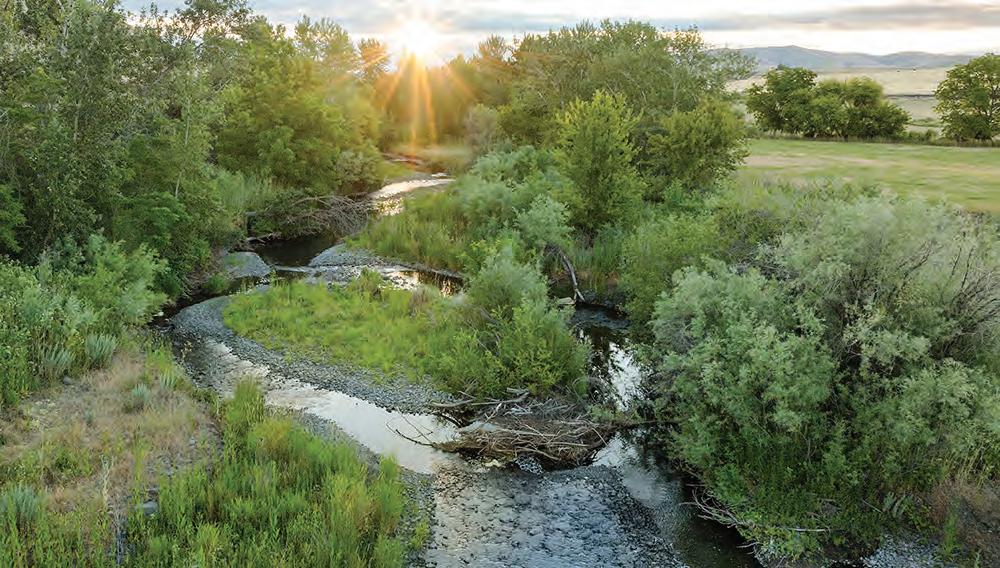
charge to restore these runs for years.
At Birch Creek Ranch, which the CTUIR will call Kwálkwal, the CTUIR will now be able to expand stream and floodplain restoration efforts. The CTUIR intends to undertake extensive stream restoration work on more than a mile of wandering floodplain, including the removal of a longstanding earthen barrier that has impeded upstream fish migration for decades. The CTUIR also plans to dedicate the ranch’s significant surface and groundwater rights back to instream flows, which will nourish the creek and floodplain below.
“Conserving Birch Creek Ranch will breathe new life into a formerly thriving steelhead and salmon stream,” said Jessica Inwood,
Washington State project manager with WRC. “We’re grateful for our ongoing partnership with the Confederated Tribes of the Umatilla Indian Reservation to support and enable some of the most significant fisheries recovery projects in the Columbia Basin.”
With its meadows, uplands and rimrock formations, the ranch also provides habitat for diverse wildlife species, including Rocky Mountain elk, mule deer, pronghorn, cougar, golden eagle, wild turkey, osprey and Canada goose. Additionally, the property includes a spring complex and section of Stewart Creek, which joins Birch Creek downstream of the property.
This work builds upon the WRC and CTUIR partnership, which is anchored by a shared vision of conserving rivers and habitat
within the CTUIR’s homeland. In a recent effort, completed in January, the WRC worked with the CTUIR, Blue Mountain Land Trust and BPA on a conservation easement over the 943-acre UmaBirch Floodplain property at the confluence of Birch Creek and the Umatilla River, downstream from Kwálkwal. This set the stage for one of the largest floodplain restoration opportunities in the Umatilla Basin, which continues today.
Taken together, these collaborative projects will bolster basin-wide fisheries recovery and improve the odds the salmon and steelhead will thrive again in the Umatilla system.
About Western Rivers Conservancy
WRC’s motto is “Sometimes to save a river, you have to buy it.” It purchases land along the West’s finest rivers and streams to conserve habitat for fish and wildlife, protect key sources of cold water and create public access for all to enjoy. For more than 30 years, WRC has taken the lead in marrying conservation and tribal land back outcomes, working with tribal nations around the West to permanently protect rivers and the lands that sustain them. WRC has created sanctuaries for fish and wildlife and secured recreational access along 250 rivers and streams around the West. Its approach to river conservation is effective, tangible and permanent. For more information, visit westernrivers.org.
Planning Department helps remove vehicles from UIR
In 2025 Environmental Health & Safety has removed about 250 vehicles and 60 RVs and camp trailers.
TRAVIS SNELL
CTUIR Communications
MISSION – The Confederated Tribes of the Umatilla Indian Reservation (CTUIR) is helping remove unwanted and unsightly non-operational vehicles from properties on the Umatilla Indian Reservation (UIR).
Brian Fullen, Environmental Health & Safety specialist with CTUIR’s Planning Department, said his office is working with UIR residents who request vehicle removals, residents who need encouragement to have vehicles removed and the salvage companies removing the vehicles.
“We’ve had several sites with sometimes up to 50 cars removed,” Fullen said. “It doesn’t cost anything with the exception that recreational vehicles and motor homes can cost up to $50 a foot. There’s also a cost to send non-metal debris to the Tribal Environmental Recovery Facility for crushing. However, I have found some funding that has paid for those. The vehicles are all crushed and recycled in the end.”
He said in most cases the Environmental Health & Safety
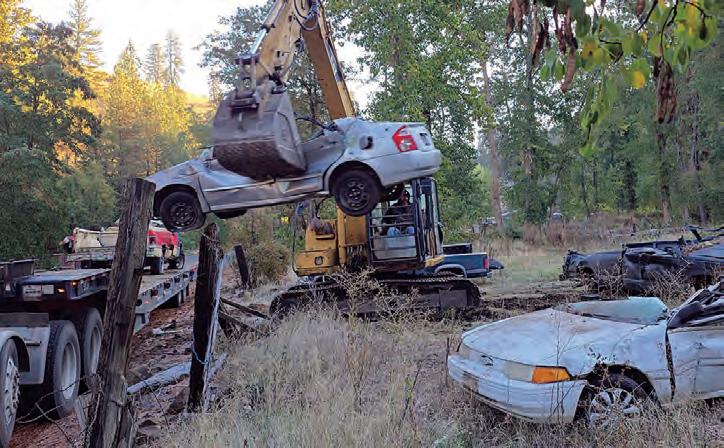
office cordially works with residents to remove the vehicles. However, in some instances warning letters were sent, and in others, citations were issued.
According to CTUIR code, Environmental Health & Safety is authorized to remove nonoperational vehicles from the UIR, including any vehicle posing a health or safety risk to the community.
The code states a property owner with more than one nonoperational vehicle shall arrange for the sale of all excess vehicles, placement of the vehicles in a closed garage or transportation of
them to a licensed auto-wrecking yard.
If the owner doesn’t follow the code, Environmental Health & Safety officers have the authority to obtain titles for the vehicles to either sell or remove them from the UIR at the owner’s expense.
If an owner can’t be located or doesn’t surrender the title, officers can post a public notice stating the vehicles will be removed if the owner doesn’t respond within 30 days of publication.
Other parts of the code include:
• Owners who demonstrate financial hardship can petition the officer for assistance;
• Vehicles with current license plates, liability insurance and are otherwise fully operational and legal for public highways are not considered abandoned;
• Vehicles not designed for highway use are not considered abandoned if they can start and operate as intended in their designs, including modifications that do not result in an increased hazard to the operator, occupant, public or environment.
So far this year Environmental Health & Safety has removed approximately 250 vehicles and 60 RVs and camp trailers with help from Stubblefield Salvage Yard in Walla Walla and Doherty Recycling in Pilot Rock.
“Removing these nonoperational vehicles significantly improves the visual appeal of the UIR, creating a cleaner and more welcoming environment for everyone,” Fullen said. “Beyond aesthetics, it’s a crucial step in protecting our environment and reducing potential hazards. By eliminating these vehicles, we also help control pest and rodent populations, which can impact the health and availability of our First Foods. This contributes to a healthier community and supports the preservation of our cultural traditions.”
For information about the removal program, call 541-2763099 or email planning@ctuir.org.
In September, the Western Rivers Conservancy, Confederated Tribes of the Umatilla Indian Reservation (CTUIR) and Bonneville Power Administration completed a 100-acre land transfer of Birch Creek Ranch in Umatilla County to the CTUIR. KYLE DUDGEON/WESTERN RIVERS CONSERVANCY
A man uses heavy machinery to put a car on a flatbed trailer Oct. 16 on the Umatilla Indian Reservation (UIR). The Planning Department is helping remove non-operational vehicles from the UIR. BRIAN FULLEN/PLANNING DEPARTMENT
Tovey elected board chair of Indian Land Capital Company
Dave Tovey has served on the board since 2007 and as vice chair since 2010. He succeeds Cris Stainbrook of the Lakota.
DANELI ATILANO
The CUJ
MISSION— The Indian Land Capital Company has announced Dave Tovey of the Cayuse and Joseph Band Nez Perce as the new Chair of its Board of Directors.
Tovey, who has served on the board since 2007 and as vice chair since 2010, succeeds Cris Stainbrook of the Oglala Lakota, a co-founder of ILCC and board chair since 2005.
Tovey is also the executive director of Nixyáawii Community Financial Services, a Native community development financial institution on the Umatilla Indian Reservation (UIR).
Tovey’s involvement in Native land issues spans decades, back to 1988 when the Confederated Tribes of the Umatilla Indian Reservation (CTUIR) became a project site for the First Nations Financial Project. At the time, he was a new economic planner.
“Obtaining project status provided us so much feedback and confidence in our efforts on things like land restoration and Farm Enterprises,” Tovey said.
In 1991, Tovey helped organize the first annual Indian Land Consolidation Conference in Pendleton. That event led to
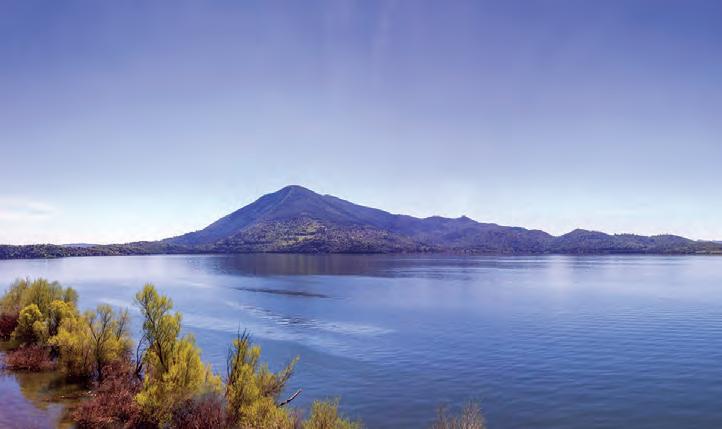
“We’ve been able to work with a number of very small tribes to achieve their first tracts of land. Can you imagine the pride and power that gives a tribe to have their place back in their hands?”
the creation of the Indian Land Working Group, which he chaired from 1992 to 1995.
Tovey was also a founding board member of the Indian Land Tenure Foundation, which created ILCC in 2005 with a $1.5 million investment.
Since then, the organization has grown to $34 million in total assets.
“We often have a loan request pipeline that exceeds what we’re able to do,” he said. “Cris is working with trusted allies and advisors in addition to our board
to craft a unique capital stack to expand our lending.”
ILCC provides financing to help Native nations reacquire land. Its lending model is distinct in that it does not require collateral. Instead it lends based on the full faith and credit of the tribal borrower.
“We do not take a collateral position on the property they’re acquiring or any other tribal asset,” Tovey said. “We feel this emphasizes their sovereignty and also demonstrates that tribes are very good credit risks.”
To date, ILCC has made 33 loans
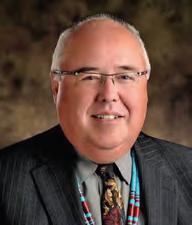
totaling $45 million. These loans have helped return roughly 70,000 acres to tribal ownership. Because the land is not encumbered by collateral, tribes can move immediately to place it into trust if they choose.
He credited Stainbrook as a longtime collaborator and mentor, saying the work ahead will build on shared efforts.
“I can only build on his legacy by doing it with him,” Tovey said. Looking ahead, he states he is most excited about the continued opportunity to help tribes restore their land bases.
“There is virtually nothing as important to a tribal government as having a land base,” Tovey said. “We’ve been able to work with a number of very small tribes to achieve their first tracts of land. Can you imagine the pride and power that gives a tribe to have their place back in their hands?”
Tovey also mentioned land acquisition on the UIR, where more than 90,000 acres have been reacquired and integrated into Tribal Farm Enterprises and other programs.
“We feel it is a blueprint for other tribes wishing to fully manage all lands and related interests on and off our reservation,” he said.

Dave Tovey
North of San Francisco is the Big Valley Rancheria. In the heart of the rancheria is Clear Lake. Indian Land Captial Company provided $2.6 million in financing for initial site preparation on a $28 million retail development. ILCC

CTUIR buys former Seventh Day Adventist building for child Care expansion
BY THE CUJ
MISSION – In an effort to expand child care services for the immediate tribal community, the Confederated Tribes of the Umatilla Indian Reservation (CTUIR) recently purchased the former Seventh Day Adventist building at 46576 Mission Road.
The nearly 4,000-squarefoot building comes with approximately 2.5acres that will allow the CTUIR Early Childhood Services Program to expand its early learning classrooms, further enhancing access to family centered, culturally grounded programming.
“The building will be renovated to serve as a day care for children 2-1/2 and older,” said CTUIR Deputy Executive Director Chanda Yates. “The total number of children will be decided during future building development team meetings, but the expansion reflects CTUIR’s ongoing commitment to creating safe, welcoming environments where children can thrive academically, socially and emotionally.”
By looking to increase capacity and program offerings, the CTUIR is addressing the region’s growing demand for child care. The expansion will also support families by offering greater flexibility in selecting child care

options that meet their needs.
“Day care is vital to young families in rural communities,” Yates said. “This initiative will provide safe reliable care for children while parents work, support early childhood development and strengthen the local economy by making it possible for families to live and thrive where they are rooted.”
The CTUIR bought the building not only because it develops infrastructure for Early Childhood Services but also because it’s a part of the Umatilla Indian Reservation.
“This building has been historically part of the community as a church school and welcomed tribal members. It is a natural fit for our goals to expand day care for CTUIR,” Yates said.
Further details about the expansion, including employment opportunities and student enrollment, will be shared throughout the coming year.
CTUIR officials signed closing documents in September, paying $500,000 for the property with funds from a Seeding Justice grant.
Seeding Justice grants support grassroots organizations and initiatives focused on social change, particularly for marginalized Oregon communities.


The Confederated Tribes of the Umatilla Indian Reservation (CTUIR) recently purchased the former Seventh Day Adventist building at 46576 Mission Road in Mission, Oregon. The nearly 4,000-square-foot building will be used to expand classrooms for the CTUIR Early Childhood Services Program. FILE
CTUIR leverages partnerships, Workforce Ready Grant for drone training
The program supports students at every step through hands-on training, wraparound support and services as well as paid work experience.
BY THE CUJ
MISSION – The Confederated Tribes of the Umatilla Indian Reservation (CTUIR) has leveraged regional partnerships and a 2023 Workforce Ready grant from the state’s Higher Education Coordinating Commission for its Unmanned Aerial Systems (UAS/ drone) training program.
Named the CTUIR Drone Project, it supports student success at every step through hands-on training, wraparound support and services as well as paid work experience.
Key partners include the CTUIR’s administrative service provider Cayuse Native Solutions in collaboration with Blue Mountain Community College (BMCC) and drone training provider DelMar Aerospace.
“The CTUIR Drone Project has exceeded our expectations. It has positively impacted the lives of several tribal community members, including myself as a graduate of the program,” Greg Penney, CTUIR member and drone project facilitator, said. “Community members should take advantage of this opportunity
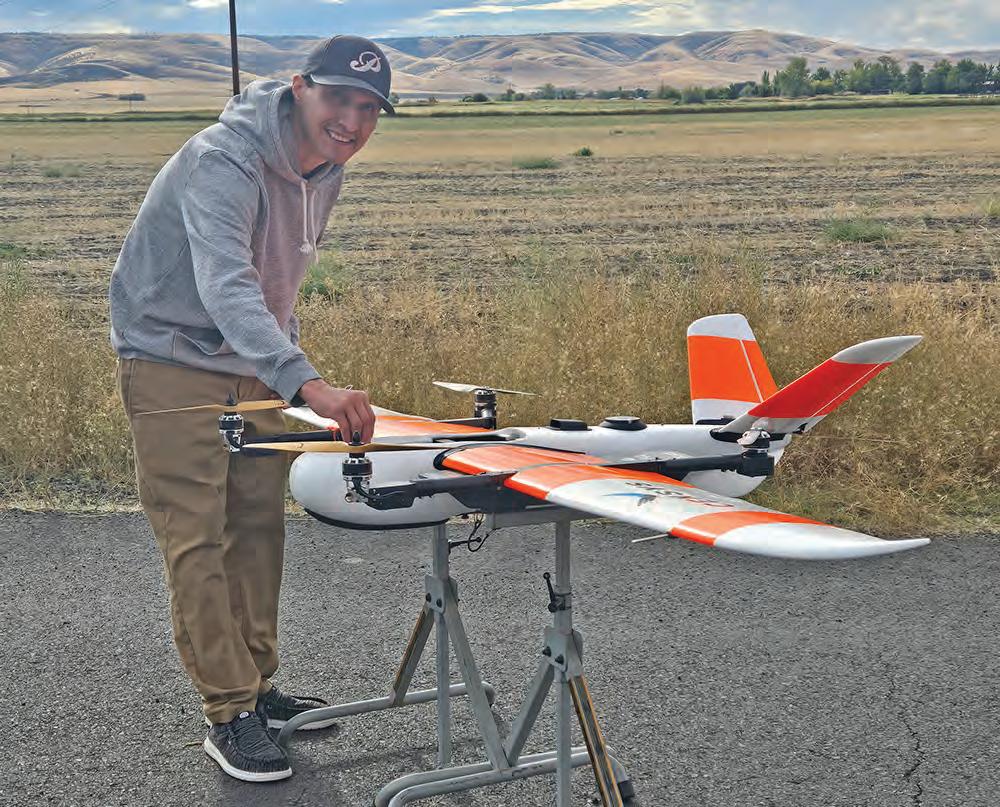
to enter the UAS industry that is projected to grow 58% in the next five years.
They will complete the program with hands-on experience, a FAA Unmanned Commercial Pilot’s License and their very own personal drone.”
Students get two training options in the program.
They can enroll in BMCC’s UAS Professional Pilot program, using simulators and real drones in 11week evening courses, or they can complete a set of fast-paced


trainings (an 80-hour Ground School and 80-hour Live Flight School) with DelMar Aerospace at its Pendleton Airport training facility.
Both options help prepare students for the Federal Aviation Administration Part 107 Unmanned Pilot’s exam to earn their drone operator’s licenses.
Workforce Ready funding supports the CTUIR and Cayuse Native Solutions in covering training costs and exam registration, providing weekly


$465 academic and $1,000 internship stipends as well as offering additional support for needs such as transportation and tutoring.
And the training program doesn’t stop when students earn their licenses because they are then eligible for a three-month internship, learning on the job from experienced drone operators while earning a stipend made possible through the Workforce Ready grant.
As trained, licensed and experienced drone operators, they get to select a drone to keep and use in pursuing future drone work or in taking additional classes to prepare for sectorspecific applications, such as using drones to gather agricultural data.
Since launching the program in 2024, which is open to tribal and community members, CTUIR has enrolled 55 participants.
Forty-three of the 55 are CTUIR members with another eight being members of other tribe, while four are non-tribal.
Twenty-eight participants have passed the DelMar Aerospace/ BMCC Ground School, and 12 participants have passed the FAA Part 107 Exam – receiving their personal $1,600 drones. Six participants have acquired employment in the UAS industry with one becoming an instructor with DelMar Aerospace.
For information, visit https:// www.cayusenativesolutions.com/ droneworkforce.













































































Richard Orna, a Confederated Tribes of the Umatilla Indian Reservation (CTUIR) employee and member, works on a drone as part of the CTUIR Drone Project.
The CTUIR has leveraged partnerships and a state grant for its Unmanned Aerial Systems (UAS/drone) training program. CTUIR DRONE PROJECT
Skamania Hatchery to close, steelhead production cut
WASHINGTON STATE STANDARD
WASHOUGAL, Wash. – There will soon be fewer steelhead released into Washington’s waters due to the impending closure of Skamania Hatchery.
Located in Clark County, the hatchery produces summer and winter steelhead that are released into southwest Washington rivers for recreational fishing.
The hatchery produces 331,000 steelhead per year, according to the state Department of Fish and Wildlife.
Operations at Skamania Hatchery will begin to slow in the 2026 fiscal year, as the state Department of Fish and Wildlife begins closing the facility.
The Washougal and Beaver Creek hatcheries will take over some steelhead production.
The Department of Fish and Wildlife estimates that closure of the Skamania Hatchery will reduce the production of steelhead in Washington by 161,000 per year after factoring in the increased fish from the other facilities.
The closure will mostly affect southwest Washington recreational steelhead anglers, said Fish and Wildlife.
The Department of Fish and Wildlife announced its decision to close Skamania Hatchery in June after not receiving its full twoyear budget request from the state Legislature.
The agency had asked for $1.9

million to maintain operations at the North Toutle and Skamania hatcheries, but got only $750,000 as lawmakers worked earlier this year to resolve a budget deficit in the $12 billion to $16 billion range.
“This funding is far short of the amount needed to sustain current hatchery operations at both facilities,” the Department of Fish and Wildlife said in its budget request for next year.
The North Toutle Hatchery produces Tule Fall Chinook and coho salmon.
With only enough funding to support continued operations at one of the two hatcheries, the Department of Fish and Wildlife determined that the benefits of keeping the North Toutle Hatchery open outweighed the benefits of

the Skamania Hatchery.
Rather than asking the Legislature to backfill its initial request amid declining revenue forecasts, the Department of Fish and Wildlife is asking for $432,000 in the 2026 supplemental budget to start closing Skamania Hatchery.
“The Department recognizes the necessity of exercising fiscal restraint this year considering falling revenue forecasts, rising caseload costs, shifting federal impacts, and increasing tort liabilities,” Department of Fish and Wildlife Director Kelly Susewind said in a letter to Office of Financial Management Director K.D. Chapman-See.
Two Skamania Hatchery staff will be reassigned to the Washougal Hatchery but stay on-
site at Skamania to oversee the three-year closure process.
Those staff members will continue trapping and fish ladder operations for returning adult fish that were released from the hatchery as juveniles.
Staff will finish closing the hatchery and begin decommissioning it once there are no more adult fish returning.
Decommissioning the hatchery will involve removing any intake or other in¬-water structures, demolishing infrastructure and restoring habitat in the area.
That process may take an additional six years after the hatchery closes and cost roughly $8 million, which Fish and Wildlife said will need to come from a future capital budget.

A wild winter steelhead caught in a Washington coastal river on the Olympic Peninsula held in the water prior to release. CHASE GUNNELL/WASHINGTON STATE DEPARTMENT
Tamástslikt exhibits to honor veterans, Native service
DANELI ATILANO CUJ
MISSION —Themes of patriotism connect a series of exhibits now on display at Tamástslikt Cultural Institute, including a traveling Vietnam War Memorial replica, a collection of historic beadwork, and a Smithsonian pop-up exhibit honoring Native service members.
Assistant Director of Operations
Randall Melton said the idea for this year’s focus began last fall when staff arranged for the traveling Vietnam Memorial Wall tribute to return.
Tamástslikt last hosted the wall in 2011.
“This year is the 50th anniversary of the end of the Vietnam War,” Melton said. “We hope to honor the memory of those we’ve lost as well as the service of all Veterans, those currently serving in the Armed Services, and first responders.”
The institute is also featuring its third annual display of Columbia Plateau beadwork from the Fred L. Mitchell Collection.
Mitchell, a lifelong collector and Walla Walla resident, has worked closely with Tamástslikt and the Confederated Tribes of the Umatilla Indian Reservation (CTUIR) as the museum seeks to acquire his extensive collection with the help of several donors.
Melton said the exhibit highlights both the craftsmanship
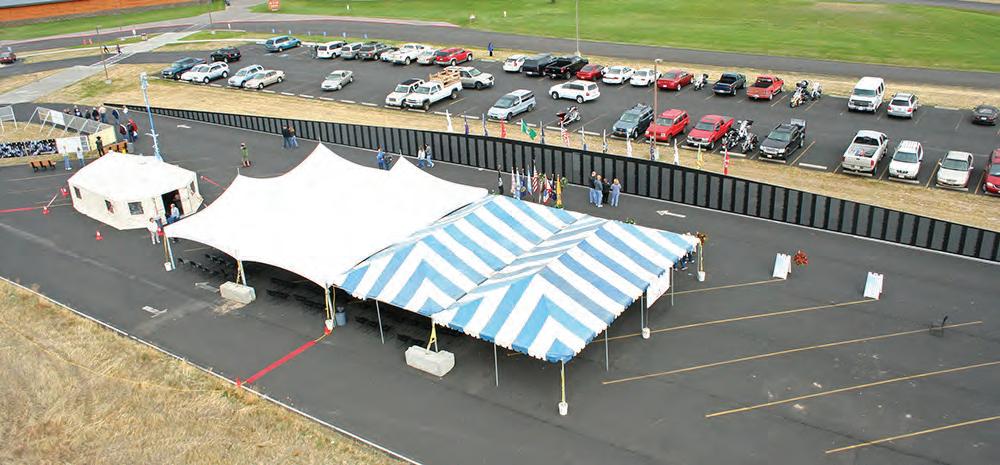
and values of Columbia Plateau beadworkers. Created between the late 1800s and 1940s, the works incorporate symbols such as eagles, U.S. flags, poppies, and laurels.
“You can see what mattered to people through the motifs they used,” he said. “These pieces show how pride and patriotism were expressed through traditional Native artistry.”
Another feature, Why We Serve, is a pop-up banner exhibit from the Smithsonian’s National Museum of the American Indian that explores Native participation in the U.S. Armed Services. It focuses on a time of great
cultural upheaval caused by assimilation policies but also highlights the high rates of Native enlistment.
“Native people had the highest per-capita involvement of any population to serve in the U.S. military,” Melton said. He added that this long history of service is deeply rooted.
“From Colonial times to today, Tribal people have made important contributions to the safety and security of this nation,” he said. “Veterans are held in very high regard and are honored throughout Indian Country.”
The America’s Freedom Tribute memorial wall will arrive at
Tamástslikt on Nov. 6, escorted by the Patriot Guard Riders. An opening ceremony is scheduled for Nov. 7 at 1 p.m., followed by daily programming and a closing event on Veterans Day, Nov. 11.
“This will be the second time Tamástslikt has hosted this tribute,” Melton said. The display includes an 80% replica of the Vietnam War Memorial Wall and additional tributes honoring veterans, active service members, and first responders.
Several CTUIR departments and community members are helping organize the display, which is sponsored in part by CHI St. Anthony Hospital.
CTUIR member's artwork to be in Indigenous Vision exhibit in Astoria
CTUIR member Lee Gavin will show his powwow photography in the show running from Nov. 8 to Dec. 21.
ASTORIA — A new art show celebrating Native artists and writers of the Pacific Northwest will open next month in Astoria.
Indigenous Visions will run from Nov. 8 to Dec. 21 at the Anita Building and will feature work by 10 artists and a chapbook with writing from 18 Native poets and authors.
Curated by Cliff Taylor, of the Ponca Tribe of Nebraska, the show brings together Native voices from Oregon and the greater Pacific Northwest. The artists and writers represent 33 different tribes.
“I wanted to curate a show that expresses some of the immense fullness and diversity of who we are as Native people today,” he said. “We’re vast and our beauty chooses a vastness of characterconfigurations and lives to express the bigness and majesty of our people.”
The show includes paintings, beadwork, photography and multimedia pieces. Among the featured artists is Lee Gavin, an enrolled member of the Confederated Tribes of the Umatilla Indian Reservation, whose powwow photography captures intergenerational subjects with authenticity and emotion.
Sophia Anderson, of the Shoalwater Bay Tribe, will present beadwork landscapes resembling watercolor postcards of her homelands. Paige Pettibon, of the Confederated Salish and Kootenai Tribes, will exhibit large-scale paintings that reflect her personal and cultural journey.
The chapbook will include work from Rena Priest, of the Lummi, and a former Washington State Poet Laureate; Laura Da’, of the Eastern Shawnee, and a National Book Award winner; and Ruby Hansen Murray, of the Osage and Cherokee Nations.

Tamástslikt


Taylor, a writer, poet, speaker and storyteller who has lived in Astoria for seven years, said the show is part of a broader effort to grow and strengthen the Native community on the Oregon coast.
“It brings joy and healing to have beauty-filled cultural events to attend and be a part of,” he said. “Indigenous Visions is such an event and occasion.”
The show is supported by a grant from the Ford Foundation,
awarded to Taylor and Liz Harris, the owner of the Anita Building. The curatorial process involved an open call for submissions, and Taylor selected works from the pool of entries. While there are currently no plans to take the show on the road, Taylor said he hopes Indigenous Visions and its chapbook can travel to other locations in the future.
An opening event will be held Nov. 8 from 4 to 8 p.m., with some of the artists.
A reading featuring contributors to the chapbook will take place Nov. 22 at 6 p.m. A merchandise table will offer prints, stickers, T-shirts, books and the chapbook for sale.

DANELI ATILANO CUJ
The America’s Freedom Tribute memorial wall will arrive at Tamástslikt Cultural Institut on Nov. 6, escorted by the Patriot Guard Riders. An opening ceremony is set for Nov. 7 at 1 p.m. at TCI.
Lee Gavin



Umatilla Tribes navigate modern development on reservation land
The Confederated Tribes of the Umatilla Indian Reservation invests in a food truck park and housing development to keep tribal members' home.
ANTONIO SIERRA
Oregon
Public Broadcasting
MISSION – Tessa Minthorn Woods is ready to start her small business, but for the past few years, she’s had nowhere to put it on the Umatilla Indian Reservation (UIR).
Woods’ specialty is Indian tacos – Tex-Mex-style tacos that use fry bread as a base. She’s been a vendor at powwows and catered events in her home community on the reservation, but when she tried to turn her side hustle into a food truck, she had trouble finding a place that would allow it.
Now, the Confederated Tribes of the Umatilla Indian Reservation (CTUIR) is trying to respond. Nixyáawii Community Financial Services (NCFS), a financial institution geared toward Indian Country, is building a food truck park where Woods plans to move as soon as it’s open.
It’s a part of a wider movement from the CTUIR government and affiliated organizations to build a more modern community on land that has belonged to the tribes for thousands of years. Doing so requires navigating cultural challenges and legal obstacles that off-reservation areas don’t often face.
“We couldn’t have designed a more hostile system for home ownership or small business ownership or even a certain level of freedom than a reservation,” Dave Tovey, NCFS executive director, said.
A food cart future
In the 1980s, Tovey said the UIR’s unemployment rate was north of 40%.
That began to change with the construction of the Wildhorse Casino & Resort in 1995. The growing revenue from Wildhorse would help the CTUIR reinvest in the reservation. Within the past 20 years, the CTUIR has built facilities for its health clinic, high school and governance center.
The NCFS office overlooks Wildhorse, which is undergoing a major expansion as the tribes add a second hotel tower to its sprawling campus. For all the prosperity Wildhorse and other tribal enterprises bring, Tovey said, a lot of the money generated “leaks” off the reservation as tribal members must seek goods and services elsewhere.
Jacob Wallis, NCFS business services manager, said the food truck idea started three years ago as the organization tried to figure out ways to support small businesses within the reservation.
“We don’t have a lot of infrastructure out here and it’s expensive to build,” he said. “So we’re like, ‘How do we kind of kill 30 birds with one stone?’”
NCFS initially planned a retail center for emerging businesses

“We live in two worlds, where we have to live in the modern world, where things have value, things have possession and possession rights.”
but pivoted after construction costs shot up following the COVID-19 pandemic, Wallis said.
NCFS staff liked the idea of a food truck park because the stakes would be a little lower. Food trucks run on a lower overhead than a traditional brick-and-mortar restaurant and if the business doesn’t work out, owners could sell the truck to a different vendor.
After raising money from public and private grants, NCFS is busy installing utility hookups, bathrooms and a covered dining area. The park will have room for six food trucks, Wallis said.
With its proximity to the casino and Interstate 84, the food truck park is primed to get the attention of visitors. But, Wallis said, the hope is that the food trucks also will cater to a tribal customer base. As NCFS solicits food trucks, he said, staff are prioritizing applications from enrolled tribal members and their descendants.
“We’re really trying to capture what it means to be a community, and we think that all of those demographics meet that standard and that need,” he said. “We really want to make sure that they feel that we see them and that they do impact our community.”
Tribal members should become more interested in the park once they see it operating, Tovey said. It’s anticipated to launch a soft opening this fall with a grand opening next year.
“Our tribe generates plans upon plans upon plans,” Tovey said. “People are used to having a lot of plans, but when they can actually start seeing and touching things, it kind of changes the game.”
‘I still want to live here’
The tribal government’s plans extend far beyond food trucks. Building homes to buy on the reservation – another area for expansion – can be even more difficult.

A lot of reservation land is held in a trust by the federal government, meaning it can’t be sold or given away by the tribes without federal consent. While it’s a key tool in the tribes retaining their land, Tovey said, policies around land transfers also led to an unintentional redlining effect. If a bank can’t use property as collateral in a loan, then it’s unlikely to issue mortgages on a reservation.
“We live in two worlds, where we have to live in the modern world, where things have value, things have possession and possession rights,” said J.D. Tovey, CTUIR executive director and Dave Tovey’s son. “But culturally, we don’t hold those. That’s something we each have to kind of wrestle with individually.”
Before entering the Office of Executive Director, J.D. Tovey was the CTUIR’s Planning director. He said the tribes saw a real need for more housing. A 2017 housing study showed that 350 homes need to be built during the next 20 years, a big number for a confederation that has about 3,200 members.
The Nixyáawii Neighborhood was conceived as a 40-lot housing project meant to provide options for middle and higher-income tribal members, who often either must move off-reservation or live in low-income tribal housing because it is one of the few options available to them. To work around the fact that neighborhood land couldn’t be sold, the tribes devised a program to lease land to prospective homeowners for 99 years.
J.D. Tovey said he had to overcome skepticism within his own tribe. Some members felt like the CTUIR should just give away land instead of leasing it. Others said residents would prefer larger acreages to modern housing development.
“I remember people saying, ‘J.D., we don’t need a metropolis,’”
he said. “And I’m like, ‘40 houses a metropolis does not quite make.’” CTUIR staff felt vindicated when nearly half of the lots sold on the first day they were available. Some residents have already moved into completed houses, while others, including J.D. Tovey, are waiting for their houses to be developed.
“We’ve now given tribal members the opportunity to say, ‘You know what, I want to become a homeowner, but I also want to move back and live on the reservation,’” said Pamela Ranslam, the homeownership services manager for NCFS. “I don’t have to buy a house off the reservation. I can now look into my own community.”
The CTTUIR has more ambitious goals for the Nixyáawii Neighborhood. J.D. Tovey said he’d like to see some of the lots used for other purposes, like a post office, a laundromat or office space. He described a future where residents could live in the neighborhood, walk to work at the nearby clinic and then catch a ride on the CTUIR’s public transportation system.
Building homes to buy is far from unprecedented in Indigenous communities. Congress created the Hawaiian Home Lands program in 1920 and the agency continues to provide 99-year leases for Native Hawaiians looking to homestead. There are new homes to buy on the Navajo Nation in Arizona, although the homes are on “fee simple” land, meaning the land can be bought and sold.
But housing remains a significant hurdle on American Indian reservations across the country. A 2017 federal report showed that there was a need for 68,000 new or rehabilitated housing units in Indian Country.
The resilience of fry bread Woods’ beaded Doritos earrings dangled from her ears as she gave a tour of her soon-to-be-operational food truck, Tessa’s Superb Tacos and Snack Shack.
Since acquiring her food truck, Woods has gotten a crash course in construction. She and her family renovated much of the truck themselves, investing thousands of dollars in the process.
But what’s remained steady throughout the process is her love of making fry bread. She noted that fry bread’s origins started in the 1800s when the U.S. government provided rations to the Navajo people as they were forced out of their land. She said the bread represented resilience as it spread to other Indigenous peoples throughout the country.
“A lot of families have their own passed down recipes,” she said. “People don’t even measure the ingredients. They just put it all together with the magic touch.”
While the developments on the reservation may have been hotly debated, Woods said, she’s excited to see the tribes building out its local community. The food truck park will let her to make a living.
“I love to cook. It’s my passion,” she said. “I love the community. I love to serve people and so I just can’t wait to be doing this.”
Tessa Minthorn Woods in her food cart on the Umatilla Indian Reservation on Sept. 15, 2025. ANTONIO SIERRA/OREGON PUBLIC BROADCASTING
J.D. Tovey


Salmon advocates seek injunction to change Columbia River dam operations
The court filing comes in response to the Trump administration cancelling a pact with states and tribes.
TONY SCHICK
Oregon Public Broadcasting
Environmental groups and the State of Oregon are seeking a court injunction to force federal dams on the Columbia River to lower reservoirs and increase the amount of water they spill downstream.
The court filing is the latest turn in the fight over the Columbia River’s endangered salmon populations. It comes after the Trump administration canceled a longterm agreement between states, tribes and the federal government to work on salmon recovery.
The Nez Perce Tribe and the State of Washington, both parties to that agreement, are expected to file briefs in support of the requested injunction, according to the law firm Earthjustice.
“When the Trump administration reneged on this carefully negotiated agreement — and offered no alternative plan to restore imperiled salmon and steelhead — we had no option but to resume our longstanding litigation to protect endangered salmon,” Earthjustice Attorney Amanda Goodin said in a press release.
The requested change in dam operations is designed to increase river flow through the dams, which makes the long ocean journey easier for young salmon.
“The stagnant, hot water reservoirs created by the dams on the lower Snake River continue to drive these fish toward extinction,” Bill Arthur of the Sierra Club said in a statement.
These steps would result in less water for generating hydropower, one of the region’s major sources of electricity.
In an emailed statement, Northwest Public Power Association Executive Director Kurt Miller called the court filing “an alarming threat to the livability of the Northwest.”
He decried the involvement of














Oregon and Washington’s governors in the litigation, saying it would harm ratepayers.
“The potential consequences are clear: less clean energy, soaring costs for families, schools, farms, and businesses, and a genuine danger of blackouts,” Miller said. “The stakes could not be higher— every Northwest resident stands to lose.”
Spokespeople for Oregon Gov. Tina Kotek and Washington Gov. Bob Ferguson did not immediately respond to requests for comment.
The Confederated Tribes of the Umatilla Indian Reservation Board of Trustees voted to maintain “unaligned amicus” status in the litigation. The tribes are not currently aligning with plaintiffs or defendants.
The agreement canceled by the White House had put an end to decades of lawsuits. It included more than $1 billion in funding for states and tribes and called for a federal government-wide effort to restore salmon.
In the short term, it created more flexibility for the federal government to generate hydroelectricity.
But the long-term aim of the agreement centered on the possible removal of four dams on the Snake River in Washington that have long been a concern for salmon advocates.
Dozens of Columbia River salmon scientists say removing those four dams is a necessary step to restoring endangered populations on the Snake River. A report from the National Oceanic and Atmospheric Administration reached the same conclusion.
Replacing the output of four hydroelectric dams is a complicated and costly endeavor, however, at a time when the Pacific Northwest faces surging energy demand and state-driven mandates to cut carbon emissions.
The Trump administration canceled several studies of how to replace the benefits of the dams.



A Spring Chinook smolt is held at the 'Imtwaha Hatchery.
Oregon State Parks charging fees at 21 more state parks
MIA MALDONADO
Oregon Capital Chronicle
SALEM – The Oregon Parks and Recreation Department has implemented new fees at some of its day-use parks and raised fees for some of its busiest overnight camping parks.
The state waives day-use parking fees at more than 225 of its state parks, with only 25 parks charging the $10 fee for in-state visitors and $12 for people visiting from out of state. But on Oct. 1, the department began requiring the parking fee at an additional 21 of its day-use parks, including:
• Beverly Beach State Park
• Bullards Beach State Park
• Cline Falls Scenic Viewpoint
• Crown Point State Scenic Corridor
• Dexter State Recreation Site
• Face Rock State Park
• Farewell Bend Recreation Area
• Fort Stevens State Park
• Harris Beach Recreation Site
• Hat Rock State Park
• LaPine State Park
•Lewis and Clark State Recreation Site
• Lowell State Recreation Site
• Oswald West State Park
• Prineville Reservoir State Park
• South Beach State Park
• Starvation Creek State Park
• Sunset Bay State Park
•Tolovana Beach Recreation Site
• Tryon Creek State Natural Area
• Valley of the Rogue State Recreation Area.
The fees don’t apply to visitors
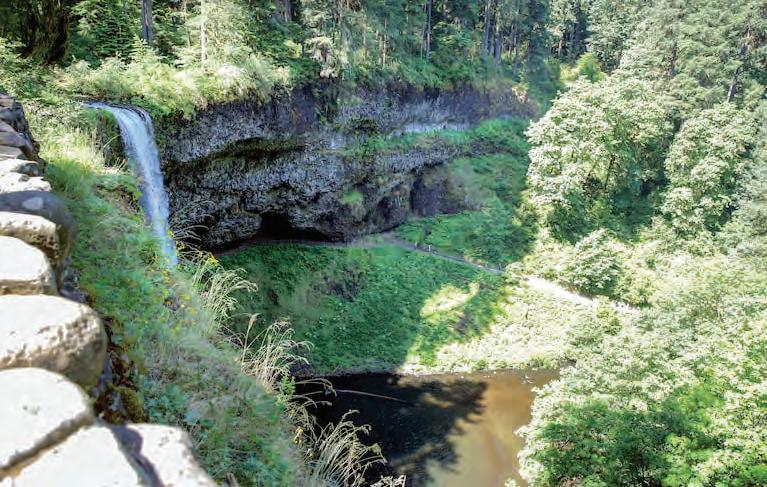
who walk, bike, use public transportation or have a valid 12to 24-month parking permit from Oregon State Parks.
These parks are some of the busiest parks in the system, according to the department. For example, Harris Beach State Park experienced an estimated 2 million day-use visits in 2024.
The changes are meant to supplement a 14% budget shortfall because of increasing costs, record visitation and a reduction in lottery funds for operations. The fee adjustments, along with internal efforts to reduce costs, will help maintain current service levels and ensure the system remains accessible in the future, the department said in the release.
The park system raised day-use

fees from $5 to $10 at the start of 2025, its first increase in 15 years.
Lottery funds cover less than half of Oregon State Parks’ budget, followed by 15% from recreational vehicle license plate fees and 35% from park fees from visitors.
“State parks are some of the most beloved spaces in Oregon, but we have struggled as a state to sustainably fund them,” Oregon Parks and Recreation Department Director Lisa Sumption said. “We’re working to reimagine the future of Oregon State Parks as a financially resilient system that will serve generations to come.”
The department is also increasing overnight rates at 29 of its busiest parks starting May 2025 to $29 a night for tents and $52 for full RV hook-ups. The parks
include:
• Alfred A. Loeb State Park
• Ainsworth State Park
• Beachside State Recreation Site
• Beverly Beach State Park
• Bullards Beach State Park
• Cape Blanco State Park
• Cape Lookout State Park
• Carl. G. Washburne Memorial State Park
• Champoeg State Heritage Area
• Cove Palisades State Park
• Deschutes River State Recreation Area
• Detroit Lake Recreation Area
• Devils Lake Recreation Area
• Fort Stevens State Park
• Harris Beach State Park
• Humbug Mountain State Park
• Jessie M. Honeyman Memorial Park
• L.L. Stub Stewart Memorial State Park
• LaPine State Park
• Milo McIver State Park
• Nehalem Bay State Park
• Silver Falls State Park
• South Beach State Park
• Sunset Bay State Park
• Tumalo State Park
• Umpqua Lighthouse State Park
• Valley of the Rogue State Park
• Wallowa Lake State Park
• William M. Tugman State Park Oregon also increased its cabin and yurt prices to a range between $72 to $129 a night, boat moorage fees increased from $15 to $20 and overnight parking and overflow camping and primitive camping fees increased from $10 to at least $15 a night. –oregoncapitalchronicle.com

Shown is Silver Falls State Park. The state has implemented fees at some of its day-use parks. KRISTIAN FODEN-VENCIL/OREGON PUBLIC BROADCASTING
Klamath River ecosystem booming 1 year after dam removal
LYRIC AQUINO
Underscore Native News + Report for America
At a press conference on Oct. 9, Klamath River scientists announced that a year after the last of the dams were removed, river health has begun to bounce back. With salmon swimming upstream, bald eagles flying overhead and increased bear, beaver, otter and osprey activity, the ecosystem is booming with ecological shifts thanks to the completion of the world’s largest dam removal effort.
“The rivers seem to come alive almost instantly after dam removal, and fish returned in greater numbers than I expected, and maybe anyone expected,” said Damon Goodman, Mount ShastaKlamath regional director for California Trout, a conservation nonprofit that works to keep waterways and wild fish healthy.
Goodman said the fish monitoring effort done by California Trout is likely the most comprehensive science and monitoring project ever done to evaluate a dam removal effort. The monitoring efforts include sonar and video weirs that track the abundance of timing of returning fish, boat surveys documenting spawning habitat and distribution of fish, telemetry for migration behavior, netting and eDNA for tagging and species composition and traps for downstream mitigation timing.
With analysis, Goodman and his team have learned that 7,700 fish passed through the former Iron Gate Dam site between October 2024 to December 2024 with an average of 588 fish per day with Chinook salmon making up about 96% of the fish that made their way upstream. Goodman said fish returned to all of the streams scientists expected salmon to return to for spawning — a trait of their life cycle called anadromy.
As of Sep. 24, researchers saw the first video of a Chinook salmon ascending Keno Dam fish ladder on the Klamath River and on Oct. 7 an image was gathered showing a Chinook salmon leaving the fishway at the top of Link River Dam and entering Klamath Lake.
“We detected fish in the sonar within the first week of dam removal,” Goodman said. “Within a couple weeks, they were all the way into Oregon spawning.”
Cooling waters Salmon rushing their way into the Klamath River is just one indicator of increasing ecosystem health in the area. The Karuk Tribe runs a network of real-time water quality monitoring stations downstream of the former Iron Gate dam. Toz Soto, fisheries program manager for the Karuk Tribe, said the water quality has increased in the Klamath River due to the sediments settling from the dam removal and water temperatures naturally regulating. When the dams were present, water collected heat over the summer resulting in hot water temperatures that lasted far longer than they typically would. Normally, a river would cool off
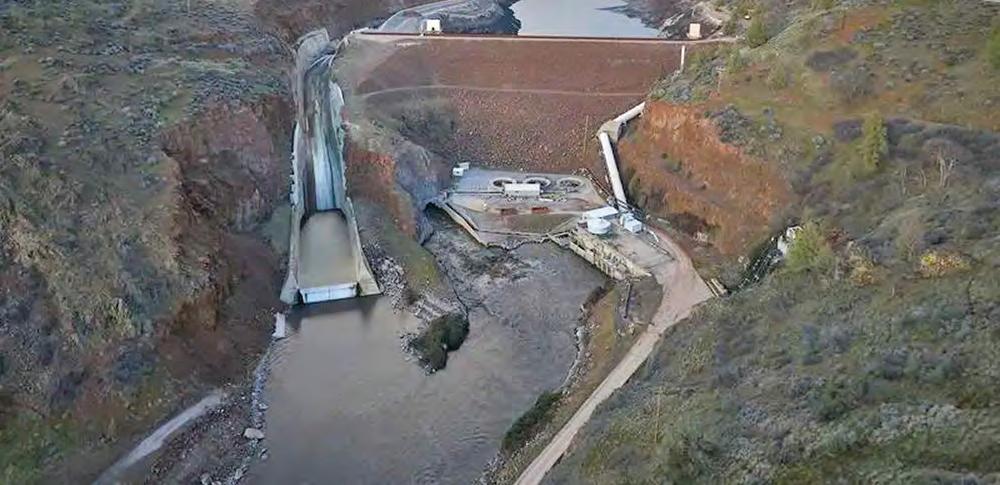
but the reservoirs in place, which Soto said were “heat batteries,” made perfect breeding grounds for harmful algae blooms.
Soto showed before and after photos during the press conference of a green toxic algae, known as microcystin, filling the former reservoir. Plants surrounding the area were brown and looked lifeless against the backdrop of the toxic water. But a year later, photos show clear non-toxic river water with wildflowers in green grasses lining the riverbank.
Fishing for footballs
Soto said that in previous years 58% of water samples taken at the Klamath River below Iron Gate dam site were above the public health limit for microcystin which can cause nausea, vomiting, diarrhea and potentially severe liver damage. Now, without the dams, 100% of the samples have been below the public health limits with 82% of the microcystin levels not even detectable.
Yurok Tribal Fisheries Department Director Barry McCovey Jr. said the Klamath’s improved water quality has made fishing easier for tribes in the area. Previously, suspended algae in the water would get stuck in the nets while tribal fisherman gillnet fished — a traditional way of fishing which the Yurok have done since time immemorial.
Fall-run Chinook salmon are entering the river earlier and traveling farther than they’ve gone in over a century, said McCovey. Historically, the fish entered early to mid-August. The first year after the dams were removed, salmon journeyed the way historical accounts have depicted.
This year, the salmon were so robust and large, McCovey said they’ve been called “footballs” by tribal fishermen. Soto m said the size of the fish can be tied back to cooler water temperatures. With the dams gone, cooler water temperatures are leading to fish migrating faster and doing so while burning less fat.
Although fall Chinook have had immediate success, the springrun Chinook population is on the brink of extinction. Historically, spring Chinook salmon were the largest population of Chinook in the Klamath Basin prior to the dams being built, said Soto. Now, the Klamath’s population of wild
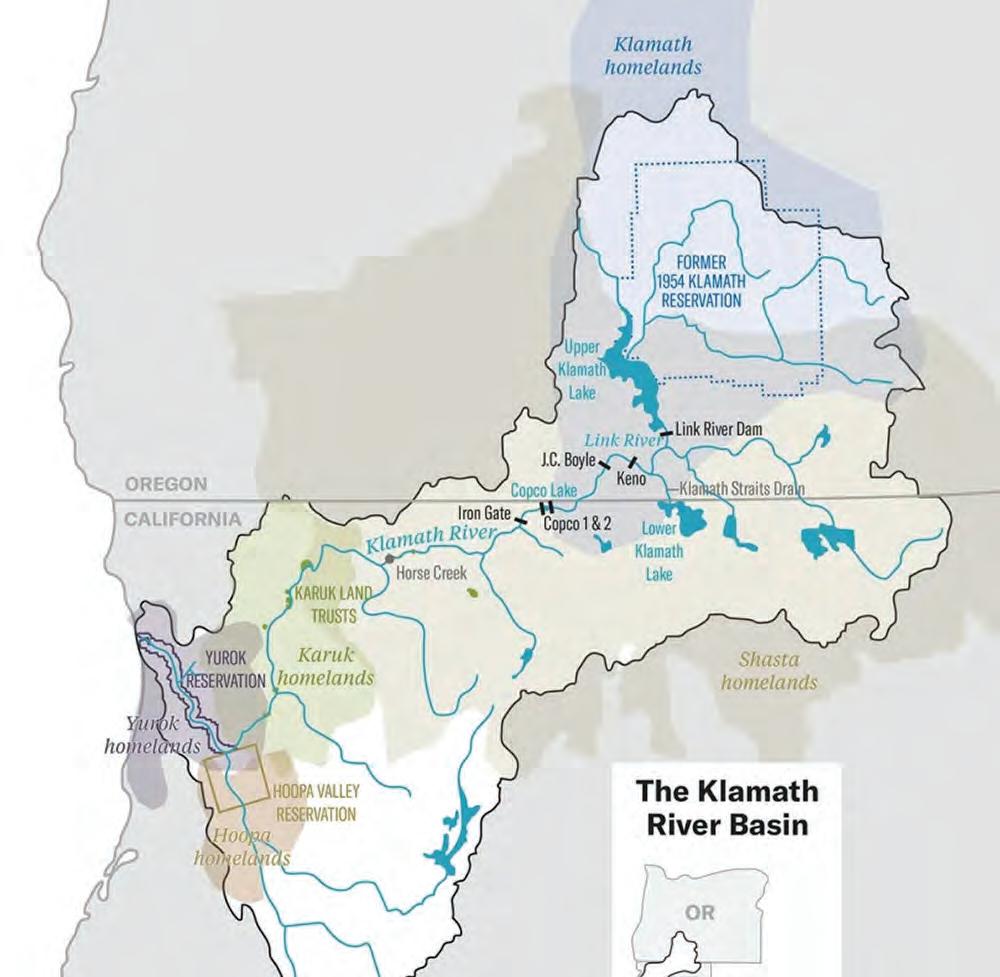
spring-run Chinook is down to just a few hundred with the nearby Salmon River hosting one of the last viable populations of springrun Chinook and a hatchery population on the Trinity River.
“The spring Chinook population today is basically on the verge of extinction,” Soto said. “So it’s a grave concern for us. But with dam removal, there’s a lot of optimism that we can recover spring Chinook.”
The future of the Klamath
Sami Jo Difuntorum, cultural preservation officer for the Shasta Indian Nation, said her tribe was impacted by the dams and with traditional villages being erased.
“We’ve been called the tribe the dams were built on and it is literally true,” she said. “The dams were built on our villages.”
After the reservoirs were drained the landscape was barren since vegetation hadn’t grown in the area for over 100 years, Difuntorum said. While people were happy with the dam removal, Difuntorum didn’t react the same way. It wasn’t until she heard the water coming through the canyon and the rocks popping as water hit them for the first time in 100 years that she felt happy.
“What it said to me was the earth and the rocks were welcoming the water back,” she said. “And so that meant healing.”
Although the river’s ecosystem has been healing, Goodman said Klamath River monitoring work has been impacted by federal funding cuts, particularly the Department of the Interior’s decision to terminate CalTrout’s funding from the U.S. Fish and Wildlife Service. He said the loss was a setback, but that the team is still seeking other funding.
“While we’re already seeing that the Klamath dam removal is a success, we need consistent and accurate data to understand how much of a success this project was,” Goodman said. “We’re currently fundraising to fill the gap for that lost funding.”
As McCovey talked with tribal members, tribal fishermen and sport fishermen in the community, he said, “there’s this feeling that the river just feels different. It feels stronger. It feels cleaner.”
Although the progress made in a year has created hope, McCovey said, the Klamath is beginning to heal from nearly a century of blockage, with “scars” that “are still fresh.”
The view over Iron Gate Dam outside Hornbook, California, in February 2024. ALEX MILAN TRACY/UNDERSCORE NEWS
Shown is the Klamth River Basin in northern California and southern Oregon. A year after dam removals, river health has rebounded. KLAMATH RIVER RENEWAL PROJECT




















Young bull rider competes at world finals in Utah
DANELI ATILANO
The CUJ
OGDEN, Utah – Tribal youth Jace Marchand, 12, recently competed at the 2025 International Miniature Bull Riding Association World Finals, held Sept. 3–6 at the Golden Spike Arena in Ogden, Utah.
An enrolled member of the Confederated Tribes of the Umatilla Indian Reservation (CTUIR), Marchand began riding at age 3 with the help of his father Loren Marchand.
He got his start mutton busting
and developed a passion for rodeo during summers spent with his dad in Nespelem, Washington.
“Jace is one outstanding young man,” said his mother, Makayla McKay. “He’s worked so hard, and I’m so proud of him.”
While he came up short at the finals, Marchand kept a positive attitude and showed determination to continue in the sport.
“After his last ride, he came to the grandstands and told me, ‘I’ll be back next year!’ with a big grin,” she said. “That right there made the whole trip worth it.”

Over the summer, Marchand competed in events nearly every weekend and brought home champion buckles from rodeos in Tonasket, Nespelem, Coulee City, Davenport and Lake Chelan.
He also gained regular experience riding bulls at Roy Leith’s each Wednesday, where he was invited to train with livestock and improve his skills.
McKay said her son represented CTUIR with pride.
Outside of rodeo, Marchand is active in sports, including basketball, baseball and football.
He enjoys fishing, hunting, video games and spending time with family. His favorite school subject is science, especially biology.
McKay expressed gratitude to the CTUIR community and the Board of Trustees for their support, saying the fundraisers and encouragement made it possible for the family to travel to Utah to support Jace at the world finals.
“We are so thankful for all the love and support,” she said.
Pendleton School District app to improve communication
The CUJ
PENDLETON — The Pendleton School District, including Nixyáawii Community School, is rolling out a communication platform called ParentSquare to make it easier for families, teachers and administrators to stay connected.
Director of Curriculum, Instruction and Assessment Matt Yoshioka said the district adopted the app to replace two systems and bring school communication under one platform.
“We were using two separate programs before — SchoolMessenger for mass phone calls and REMIND for texts,” Yoshioka said. “Moving to ParentSquare allows us to use one program to fill all our needs, and it’s also a cost-saving change since the combined cost of the other two was higher.”
Yoshioka said reaching all families was sometimes a challenge with multiple systems.
ParentSquare, he said, allows the district to send messages by text, email, phone call, or app notification all at once.
Teachers can share newsletters, the district can send electronic permission slips and parents can choose whether to receive instant notifications or a daily summary.
“ParentSquare allows us to communicate in every way from one place,” Yoshioka said. “It gives families more flexibility and keeps information consistent.”
At Nixyáawii Community School, Principal Ryan Heinrich said the platform will be used for daily updates and classroom communication.
“We will use ParentSquare for day-to-day announcements,” Heinrich said. “Teachers will also use it for different classes and parent communication.”
Heinrich said the school’s media class will have a role, too. “Our media class will produce monthly newsletters to post on the app.”
DANELI ATILANO
Jace Marchand began riding at age 3 with the help of his father Loren Marchand.
LETTER to EDITOR
DCFS and Nicht-Yow-Way elders give thanks
DCFS and Nicht-Yow-Way Elders would like to thank the following program and individuals for your generous donation and/or service to make the 2025 CTUIR Elder Day a success.
Donors are Walmart, Alvin VanPelt Sr., Marie Dick, Kathryn Munden, Hilda Alexander, Jackie Barkley, Brittney Eickstaedt, Pendleton Round-Up, Emily Oatman, Roberta Wilson, Lenora Spino, Cleo Dick, Yellowhawk Tribal Health Center Health Commission, Susan Sheoships, Cayuse Holdings, CTUIR General
Council, Tami Gallegos, Lorena Thompson, Marlene Taylor, Warm Springs Elders, CTUIR Human Resources, Julie Taylor, Wildhorse Resort Casino, Family Engagement and Food Distribution Program on Indian Reservations.
Volunteeers are Corinne Sams, Anson Crane, Cayuse Singers and CTUIR Youth Leaders, ticket sellers Jackie Barkley and Victor Bates, servers Toni Cordell and Kim Minthorn, Shawna Gavin, Michael Ray Johnson and BOLSTER.
Family of Shalaya Williams give thanks
The family of Shalaya Williams would like to express our heartfelt gratitude for the tremendous outpouring of love, prayers, and support during Shalaya’s courageous cancer journey and following her passing.
Your kindness and generosity have brought great comfort to our family during this difficult time.
We are deeply thankful to our relatives, friends, community members, and organizations who surrounded us with compassion, including: Irma Totus, Ernestine
Morningowl, Bobbie Conner, Thomas Morningowl, Elsie Dave, Armand Minthorn, Mike Squeochs, Jess Nowland, Randy Minthorn, the Wáašat singers, CTUIR Public Works, Longhouse Cooks, Andrew Wildbill, Sam Spino, Freddie WarBonnett, Jacy Sohappy, Látis Nowland, Troy Douglas, Fabian Quenelle, Acosia Red Elk, Camas Logue, Kay & Chaz Webb, Kathleen Elliott & Angela HummingbirdJohnson, Julie Taylor, CTUIR DCFS, Native Wellness Institute,
The Joseph Family, Keysha & Aaron Ashley, her Arizona Family, Future Generations Collaborative, Nike United Native American & Friends Network, 7 Waters Canoe Family, Wapato Farm, Jenny Arthur, Andrea Tulee, Jackson McCormack, Sydelle Harrison, Jay Stanley, Celeste & Tyera, Jaci & Joyce & Tyrone, Modesta & Shelly Minthorn, Gabe & Robin Minthorn, Terri Carnes, Lisa Ganuelas, Mort Bishop III, Becky Waggoner, and all of her Dear Portland Friends.
Thank you to all of you who came to services, offered support, or sent loving thoughts and prayers to our family.
Your prayers, visits, songs, meals, and generous acts of love will forever be remembered and cherished.
Shalaya’s spirit lives on in the hearts of all who knew and loved her.
With deepest appreciation and love, the Family of Shalaya Williams
Thank you from Gloria Shawaway Williams' family
Please accept all my heartfelt thanks as we sent my mother Gloria Shawaway Williams home to be with her mother, father, siblings and beloved friends and family in August.
It has taken me some time to finally be able to write this.
We are still learning how to live a new normal without her.
We miss her every day but knowing how loved she was in the community has helped in our healing.
The outpouring of support during our time with her in Portland was incredible.
The love and support we received during and after her services was so helpful and I could not have been happier than how well her services went and how many people she brought together. It
was beautiful.
There are a lot of people to thank, so please excuse me if I forget anyone. We will remember everyone at the memorial we will be planning for next year in August 2026. At that time the memorial will be for my mother and her brother Marvin Shawaway. So again, thank you to everyone for the kind words, the prayers, the songs and the love our whole family has continued to receive.
Thank you to the Umatilla Tribal Fire Department, Good Samaritan Hospital in Portland, Yakama Nation, Burns Mortuary, CTUIR Board of Trustees, CTUIR Communications Department, Yellowhawk Tribal Health Center, •Yellowhawk Tribal Health Center Health Commission, CTUIR Department of Natural

Resources, CTUIR Cultural Resources Protection, CTUIR Gaming Commission, Michael Ray and Shawna Gavin, Father Mike Fitzpatrick, Katrina Burnside, Eugena Stacona, Rob Burnside, Wenix Red Elk, Teara Farrow Ferman and Sophia Ferman, Keysha Farrow, Tiyapo Farrow, Aaron Ashley, Matt Farrow, Patty Farrow, Casey Farrow, Mitzi Rodriguez, Paula and Kris Pouwakee, Judy Farrow, Kootise Burke, Alvina Burke, Alaina Mildenberger, Althea Wolf, Stella Wolf, Mania Wolf, Linda Sampson, Michelle Thompson, Appalonia, Teresa Crane, Jeremy Wolf, Jennifer Karson Engum, Naomi Stacey, Boogie (Chuck) Sams, Michael Minthorn, Greg Penney, Emile Bill, Robert Taylor, Rhonda and Colin Craig, Sonya
Lloyd, Dorothy Jones, Andi Scott, Titto Moses, Cici Moses, Bobi Dee Tallman, Luka Worden, Ryan Oatman, Preston Eagleheart, Brentton Dunfee, Marcus Dunfee, Seth Christiansen, (Little) David Wickert, Darren Burnside, Robert Windyboy, the Zach Family, Martina Gordon (It was Live NOT Memorex), to everyone who sent the beautiful flowers and last but definitely not least, my cousin Fabian Spencer who is always everywhere and doing everything needed in any situation.
A special thanks to her for organizing the GoFundMe and helping us navigate that, and to all the ones who donated. Your help was immeasurable.
All our love, Dara, Aaron, Luka and the family of Gloria Shawaway Williams.

Tamúutsanmay
Shalaya Williams
Shalaya was born on May 10, 1982 in Pendleton, Oregon to Roberta Williams and Robert Jones and passed peacefully on October 12, 2025. She was a proud descendant of the Akimel O-odham and enrolled member of the Confederated Tribes of Umatilla Indian Reservation.
She arrived into her family circle with thick black hair and huckleberry eyes, as one uncle described her. As a child she was energetic.
Her dad recalls a time when she competed in a track meet and he watched as dust was flying and Shalaya came running through it in first place, beating everyone by far.
She was an athlete and loved basketball. She played in the first BADD tournament at 8 years old and basketball continued to be her sport. She loved dancing as well as working out and weightlifting.
She attended and graduated from Chemawa Indian School and made many lasting friendships throughout
Michael James McCloud
SUMUCK - Michael James McCloud - Age 76, Passed away peacefully on Tuesday, October 21, 2025 at his home in Mission, Oregon.
Michael was born on May 12, 1949 in Pendleton, Oregon to Andrew and Edith (Kanine) McCloud.
His early years were spent in Cayuse, Oregon until the age of 9, when his family moved to the Washington Coast.
He was raised the rest of his childhood at Franks Landing in Nisqually, Washington. He attended school in Yelm, Washington. He learned to fish, smoke salmon, and canoe. As a young adult he fought in the Fish Wars and marched in Washington D.C.
He was very passionate about protecting treaty rights and saving the salmon. He loved fishing on the Columbia River with his brothers and mom.
He enjoyed sports (basketball, running, volleyball and everything in between). He worked for the Nisqually Fisheries Program before moving back home to the Umatilla Indian Reservation where he would settle down and

IN REMEMBERANCE
Indian Country. A few years later she attended and graduated from Haskell Indian Nations University in 2010 with a business management degree and her family of friends grew.
Shalaya, also known as Shugga Shay to some, was friendly, outgoing, resilient, a leader and as colorful with so many diverse friends. Her Indian name, Tamúutsanmay or Gambling Woman, described her love for stickgame.
She traveled the Northwest and beyond to sing, gamble, laugh and connect with others. She even led the stick game club while at Haskell and started the first stickgame tournament during the tribe’s Wild Horse pow wow weekend.
Shalaya loved her nieces and nephews and enjoyed watching their games and other activities. She smiled with pride recently as she attended her last Pendleton Round Up’s Happy Canyon and cheered for her family members participating.
She had her last stroll through the tipi village- a place she remembered fondly, especially camping as a child
with her grandmother, Tessie, hosting dinners and running around camp.
Like her grandma, Shalaya was adventurous. She loved to travel and that took her to India, Costa Rica, Australia and New Zealand. She even lived in Hawaii for nearly a year.
She loved music and going to concerts. She loved paddling on the canoe and experiencing canoe journey. She loved the outdoors from hiking to rafting to farming and camping.
She loved to work hard and had many interesting jobs- a cultural preservation worker at Tamastslikt Cultural Institute, she moved to Portland and worked at the Nike World Headquarters. She became her own boss and sold Native clothing products throughout the U.S.
She found a love for construction and was attending the Northwest Construction School and working on an all-Native construction crew where she easily outlifted all of the men. She broke trail for other women in this industry and pushed back against discrimination. She was
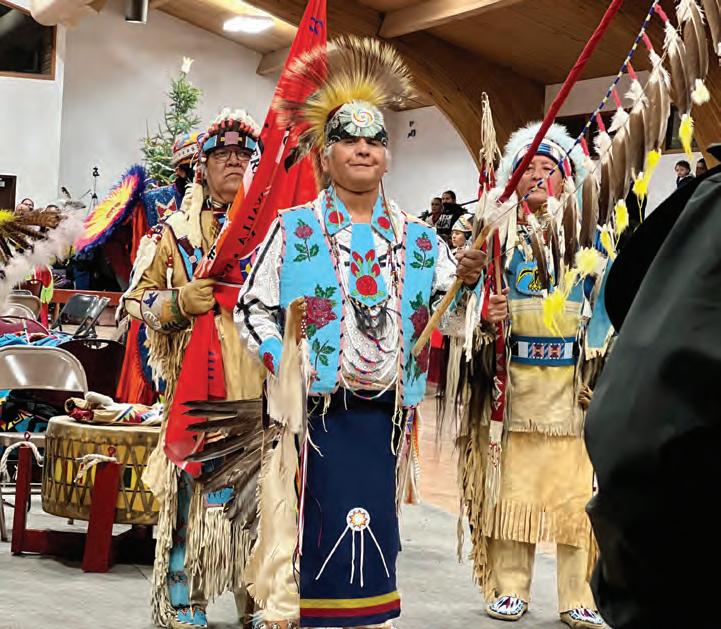
raise his two youngest children.
He worked for the CTUIR Department of Natural Resources as a Fish Technician for 33 years before retiring.
He enjoyed cooking salmon traditionally and sharing his knowledge to anyone who wanted to learn.
He loved to spend time with his
kids and grandchildren, make macrame chairs, do beadwork, dance traditional, visit with family and friends, take many pictures with his disposable cameras, and travel.
He was preceded in death by his parents Andrew McCloud and Edith Kanine McCloud, brother Russell McCloud and sisters
becoming an accomplished MC and dabbling in video production. Her grandmother Tessie had a profound impact on her life. She talked about her often and repeated the teachings that were instilled in her by her grandma. Shalaya aspired to be like her.
She loved to be the big sister or auntie to others where she would give guidance, just like her grandma did for her. She went out of her way to do this because she wanted to protect you and make sure you did good things and to be proud of who you are. She wasn’t afraid to scold you, either.
Shalaya was a genuine person who loved life to the fullest. She gave her best and expected the best from you. She had a strong faith in the Creator and her tribal ways. She battled cancer for the past year and was a true warrior woman through it all- inspiring those around her with her courage and bravery. She was comforted knowing that her grandma would be there to greet her.
Her parting words: “drink water.”
Linda McCloud, Patricia McCloud Kalama, and Billie McCloud McGee. He is survived by his daughters Melissa McCloud and Sammantha McCloud and his son Garrett McCloud (Alyssa). His grandchildren: Rosie and Sky Fox, Sis and Izzi Moses, and Leroy and Henry McCloud. He is also survived by his brothers: Andrew McCloud III (Melinda), Kenneth McCloud (Mary), Raymond McCloud and sisters: Norma Eaglespeaker, Marcella Eaglespeaker (Otto), Gail Hernandez (Rudy), Angeline Totus (Frank), Rosaline Johnson, and Maiselle McCloud. As well as many nieces, nephews, grand nieces and grand nephews.
A dressing and viewing ceremony was held at 2 pm on Thursday, October 23, 2025 at Burns Mortuary Chapel in Pendleton, Oregon.
Followed by a procession to the Mission Longhouse. A dinner service was held at 5 p.m. on Thursday at the Longhouse, followed by a Washat Service.
Morning services began at 7 a.m. on Friday, October 24, 2025 at the Longhouse with a Procession to Homly Cemetery for burial and 8 a.m. Followed by a giveaway and meal.

Yellowhawk offers LGBTQ+ training to community
DANELI
The
CUJ
ATILANO
MISSION — Yellowhawk Tribal Health Center held a training on Oct. 21 aimed at improving understanding and care for LGBTQ+ and Two-Spirit community members.
The session, titled Being Attuned with Two-Spirit and LGBTQIA+ Individuals, was led by Joy Garcia, a mental health counselor at Yellowhawk.
Garcia developed the training in response to requests from local LGBTQ+ and Two-Spirit individuals who wanted to see more representation and awareness in community services.
The three-hour session, held in the Nixyaawii Governance Center's Wináha and Qapqápa conference rooms, provided education on LGBTQIA+ identities, pronouns, and challenges related to gender and transitioning.
“Healthcare professionals in the United States on average receive only 4.75 hours of education regarding LGBTQ+ individuals over the course of their entire educational process,” Garcia said, citing research from the National Library of Medicine. “This leads to a lot of discrimination, misgendering and harmful practices across the country.”
The training introduced participants to best practices and standards from the American Psychological Association and the World Professional Association for Transgender Health (WPATH).
Attendees also learned how to

“Education helps people understand, grow in their empathy and be able to gain new skills in communicating with someone who may have a different experience than they do.”
communicate with people who are coming out and were encouraged to reflect on their own thoughts and feelings about gender and identity.
Garcia said the goal was not to make participants experts
but to help them gain tools and awareness that can improve future interactions.
“Community members interact with members of the queer community every day in their jobs and personal lives,” she
said. “Education helps people understand, grow in their empathy and be able to gain new skills in communicating with someone who may have a different experience than they do.”
A portion of the session focused on Two-Spirit identities, a term coined by Native LGBTQ+ individuals in the 1990s.
Garcia explained that while it can be used broadly for LGBTQ+ Indigenous people, it can also refer to culturally specific thirdgender roles that existed in many tribes before colonization.
“These individuals had special places in the tribes, with tribal language to reflect that,” Garcia said. “As colonization, specifically in conjunction with religion, occurred, these identities were erased.”
The training included historical context, elder interviews, and videos from Two-Spirit powwows, offering participants a deeper understanding of gender diversity within Native cultures.
Garcia said the session was part of a larger effort to decolonize gender and reclaim traditional understandings within Tribal communities.
Attendees were provided with additional resources and tools to support LGBTQ+ and Two-Spirit individuals in their families, workplaces, and community roles.
Garcia said she hopes the training will continue to spark conversations and help create a more inclusive and supportive environment at Yellowhawk and throughout the CTUIR community.
2 UTPD officers receive commendations
BY THE CUJ
MISSION – Two Umatilla Tribal Police Department (UTPD) officers recently received commendations for actions they took that helped saved two lives in separate incidents.
Officer Ryan Bernards received a commendation for his life-saving actions during Pendleton RoundUp.
According to a UTPD commendation, while patrolling the Teepee Village on Sept. 13, a group of children approached Bernards informing him of an infant choking inside the village. Bernards followed the children to the infant and performed a “finger sweep” to dislodge the object on which the infant was chocking.
Once the infant began breathing again, Bernards stayed on scene until medical personnel arrived. The infant was then transported to CHI St. Anthony Hospital for
evaluation.
“This is a great example of the work police officers do daily and shows the dedication and competency of Officer Bernards to the service and safety of the public,” the commendation states.
Bernards, who joined the UTPD on Aug. 18 after 10 years with the La Grande Police Department, said his actions were “appropriate to the situation” and that he doesn’t
“My
child until the paramedics arrived. I do believe the child is perfectly fine, but I did not have any more contact after the paramedics took over and they were in the ambulance with the child.”
Confederated Tribes of the Umatilla Indian Reservation members annually host the Teepee Village during Round-Up, which normally includes more than 300 teepees set up by Native
thoughts on helping the driver were that I would do everything I could to help the man until either more help arrived, or I was physically unable to continue."
seek praise. Although he said it was nice to be recognized, what he found impressive were the children who sought him for help.
“They provided only the needed information and led me to the infant,” he said. “Once it was obvious the child was receiving oxygen, I gave the child back to the mother and we monitored the
Americans from around the Pacific Northwest.
Officer Paul Heimbach, who has been with the UTPD for five years, received his commendation for helping resuscitate an elderly man on Sept. 21.
According to Heimbach’s commendation, during a call to assist Oregon State Police (OSP)
for a single-vehicle crash on Interstate 84 near mile post 224, Heimbach arrived first to find an elderly adult male unresponsive in the driver’s seat.
Recognizing the man needed care, Heimbach removed the driver and performed CPR for 10 minutes while waiting on OSP and an ambulance to arrive.
Once paramedics assumed care of the driver, Heimbach assisted with the landing of LifeFlight to transport the driver via helicopter to the hospital.
“My thoughts on helping the driver were that I would do everything I could to help the man until either more help arrived, or I was physically unable to continue,” he said. “The public depends on police and fire to come to their aid in their time of need. To give up prematurely or not give every available ounce of effort would be letting down the public, and that was not an option.”

Yellowhawk Tribal Health Center's mental health counselor Joy Garcia during a previous training on mental health. JORDAN STEWART/CUJ
DEPARTMENT OF NATURAL RESOURCES
Special to the CUJ
Food waste and renewable energy are the topics of discussion for Confederated Tribes of the Umatilla Indian Reservation's (CTUIR) upcoming Biogas Workshop on Friday, Dec. 5 at the Mission Longhouse.
This workshop will focus on CTUIR’s potential to harness biogas energy using the anaerobic digestion process and will provide a free kit with hands on learning about the chemistry and engineering involved.
Depatment of Natural Resources (DNR) First Foods Policy Program (FFPP) is partnering with biogas expert David House, author of The Complete Biogas Handbook, to host this workshop and invites all who are part of our regional food and energy systems to participate.
This workshop will be held on Friday, Dec. 5 at the Mission Longhouse and will be open to all who would like to participate.
Audiences include those involved in agricultural production, renewable energy, public utilities, waste and materials management, food processing, restaurants and food service, students from high schools and colleges, and leaders from around our region.
Participants will receive a free kit to try their own home biogas
Yellowhawk hosts community food drive
BY THE CUJ
CTUIR to host workshop on biogas Dec. 5 powers you? what
MISSION — Yellowhawk Tribal Health Center has organized a community food drive to support families affected by the ongoing pause in Supplemental Nutrition Assistance Program (SNAP) benefits and the federal government shutdown.
The drive has no set end date and aims to help families through the uncertain period, especially as the holiday season approaches.
Yellowhawk staff plan to distribute food and essential items in time for Thanksgiving to ensure community members have access to needed resources.

Donations of nonperishable, nonexpired food items can be dropped off at the main entrance of Yellowhawk, near the switchboard.
Contributions will be distributed with assistance from the Confederated Tribes of the Umatilla Indian Reservation Department of Children and Family Services (DCFS). Additional donations will be shared with St. Andrew’s Mission, which provides support to anyone in the community.
Yellowhawk emphasized that every contribution helps make a difference for families impacted by the benefit pause.
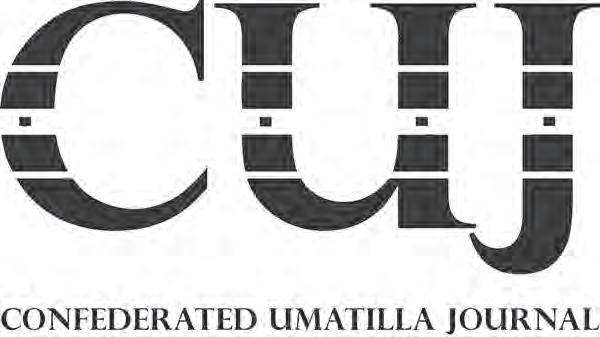

Wanda Exec. Director, Turtle Cove Created a comfortable home and haven for her community, and families in need.
DeArcie Abraham, owner of composting business Biowaste Technologies who is a partner in the workshop, shows off the Áqpaš (Umatilla word for “stomach”), a small-scale anaerobic digester that turns food waste and manure into garden fertilizer and renewable natural biogas energy. Participants in the workshop will learn how to make these biogas digesters and receive a free kit. DNR
Hill shares Umatilla culture through music in Norway
DANELI ATILANO
The CUJ
MISSION — Fred Hill, a member of the Confederated Tribes of the Umatilla Indian Reservation (CTUIR), spent several weeks this fall performing and sharing tribal culture in Norway as part of a cross-cultural music project titled I Was Here.
Hill first connected with Norwegian musicians Nils Nygaard and Martine Kraft in 2014, when the pair performed at the annual Tamkaliks Celebration in Wallowa after being invited to the United States by a mutual friend.
“They liked it here and wanted to come back,” Hill said. “But the only way they could return was through an invitation that included a cultural collaboration.”
Hill sent the duo a CD of original songs titled Songs of My Heart. They later incorporated Hill’s music into their performances, blending his drumming and vocals with Kraft’s Hardanger fiddle and Nygaard’s guitar.
The collaboration grew into a long-term friendship and ultimately led to Hill’s invitation to join the I Was Here production in Norway.
Hill traveled to Norway twice in 2025, first in August for rehearsals and again from Sept. 18 to Oct. 9 for a full tour.
The group performed at area schools near the town of Jøvik, where Hill appeared in traditional regalia and shared stories of his upbringing, tribal history, and the Umatilla language.
“I would share how I was raised by a non-English-speaking grandmother and how our people are still striving to preserve our language,” Hill said. He also described the students’ reactions to his performances.
“Some of them would be laughing and giggling at first, but many were just amazed. They’d ask if we always dressed that way or if they could touch my hat.”
During each performance, Hill’s segment included a question-andanswer session with students. Nygaard and Kraft translated between Norwegian and English, helping students understand Umatilla history, treaty rights, and powwow traditions.
Hill said one of the highlights was performing “Fred’s Song,”

a piece written in his honor that incorporated his powwow-style drumming.
“They created a beat and I came in with my own rendition,” he said. “It was quite an honor to be included.”
In addition to the performances, Hill was welcomed by his hosts’ families, who shared traditional Norwegian meals, including lamb, seafood chowder and local desserts.
He also visited cultural landmarks such as the Lillehammer Olympic site and an underground hockey arena built into a mountain.
Before returning home, Hill presented his hosts with a CTUIR tribal flag and hopes to pursue an official friendship proclamation between the tribe and the I Was Here production.
“I just wanted to share our culture in a good way,” he said.
“This was a lifetime experience.”
The I Was Here team plans to release a recorded album, I Was Here II, in 2026, featuring Hill’s contributions.
The group’s current music, including Fred’s Song, is available on Spotify under I Was Here.




Fred Hill, a member of the Confederated Tribes of the Umatilla Indian Reservation, spent several weeks this fall performing and sharing tribal culture in Norway as part of a cross-cultural music project titled I Was Here. COURTESY PHOTOS
Yellowhawk highlights care access, cultural strength
DANELI ATILANO
The CUJ
MISSION — A day of connection, advocacy, and healing brought the community together at Yellowhawk Tribal Health Center on Oct. 21 as events highlighted the importance of access to care, cultural strength, and recovery.
The day began with the grand opening of Yellowhawk’s mammography unit, marking an important step forward in women’s health for the Confederated Tribes of the Umatilla Indian Reservation (CTUIR).
The equipment will allow women to receive screenings close to home, reducing delays and improving early detection.
Breast cancer survivor and national Native health advocate Karen Malcom shared her personal story during the event, describing her journey through diagnosis and treatment. She emphasized the need for awareness and early screening in tribal communities.
“Having this new mammography machine at Yellowhawk means our women can get screened close to home, without delay,” she said.
Her remarks were met with gratitude from attendees, who applauded her advocacy and Yellowhawk’s commitment to expanding preventative care. The celebration honored not only new technology but also the strength of women who lead efforts for health equity in Native communities.
Following the opening,
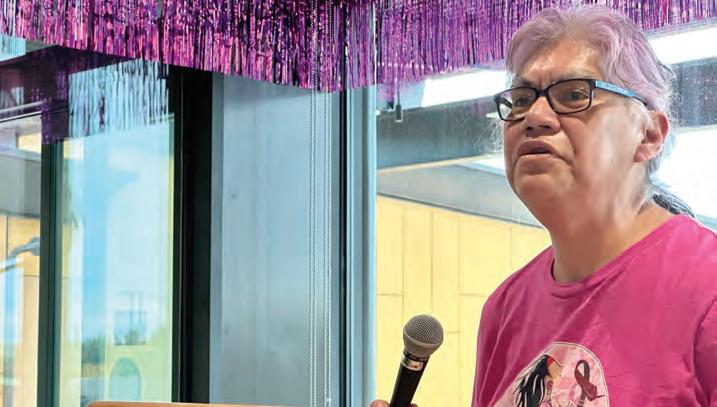
Yellowhawk hosted an open house, inviting the public to meet staff and learn about the organization’s wide range of programs and services. Departments from behavioral health to youth outreach participated, offering information about available resources and ongoing initiatives. The event fostered connection, education, and community pride while highlighting Yellowhawk’s holistic approach to health.
The evening concluded with the “Strengthening Our Community” Tribal Opioid Summit, a collaborative event focused on education, prevention, and healing. Representatives from the Northwest Portland Area Indian Health Board’s Tribal Opioid Response (TOR) Network, Larissa Molina and Lexy Packer,

PARENTSQUARE
CONTINUED FROM PAGE 1
The school also plans to use ParentSquare, along with its website and Nixyáawii app, to share information about weatherrelated delays and closures.
ParentSquare also supports over 100 languages, allowing users to receive messages in their preferred language. Yoshioka said this helps make communication inclusive
for parents and guardians.
He said families can request help setting up or using the app while cutting down on platforms parents need to manage.
“We’re trying to limit the number of apps families have to use,” he said. “We encourage parents to have three — ParentSquare for communication, ParentVUE for student schedules and grades, and FirstView for bus information.”
Families can download the app
“We encourage parents to have three — ParentSquare for communication, ParentVUE for student schedules and grades, and FirstView for bus information.”
delivered a presentation on the opioid epidemic’s effects in tribal communities and shared information about life-saving tools such as Naloxone (Narcan).
“The information shared by Larissa and Lexy was not only eye-opening but deeply necessary,” said Jessica Collins, Yellowhawk Behavioral Health Chemical Dependency Prevention Coordinator. “Their work is saving lives, and their commitment to tribal communities is inspiring.”
The summit also featured a powerful panel discussion with three individuals in recovery who shared their experiences with substance use disorder and their paths toward sobriety. The panelists—Fernando Poveda and Ronnie Rodriguez, both peer recovery mentors at COPES in
Pendleton, and Emma Byers, a direct support professional at Horizon Project Inc.—spoke candidly about the struggles that led them to addiction and the turning points that helped them begin recovery.
They discussed the role of trauma, mental health, and environment in addiction, as well as the tools that have supported their healing journeys, including Medically Assisted Treatment (MAT), community programs, and cultural and spiritual grounding.
Adding to the data-driven portion of the evening, Justin Monahan and David Barba from Nepenthe Laboratory Services in Eugene presented recent findings on drug use trends across Oregon, Washington, Idaho, Colorado, Nevada, and Northern California. Their research included insights specific to tribal communities, providing context for how substance use patterns continue to evolve regionally and locally.
The event concluded with a presentation from Detective Drew Hubel of the Blue Mountain Enforcement Narcotics Team (BENT), who discussed law enforcement efforts to combat drug trafficking and use in Umatilla County and on the Umatilla Indian Reservation. He noted the partnership between BENT and the Umatilla Tribal Police Department, emphasizing how collaboration between tribal and regional agencies helps protect community health and safety.
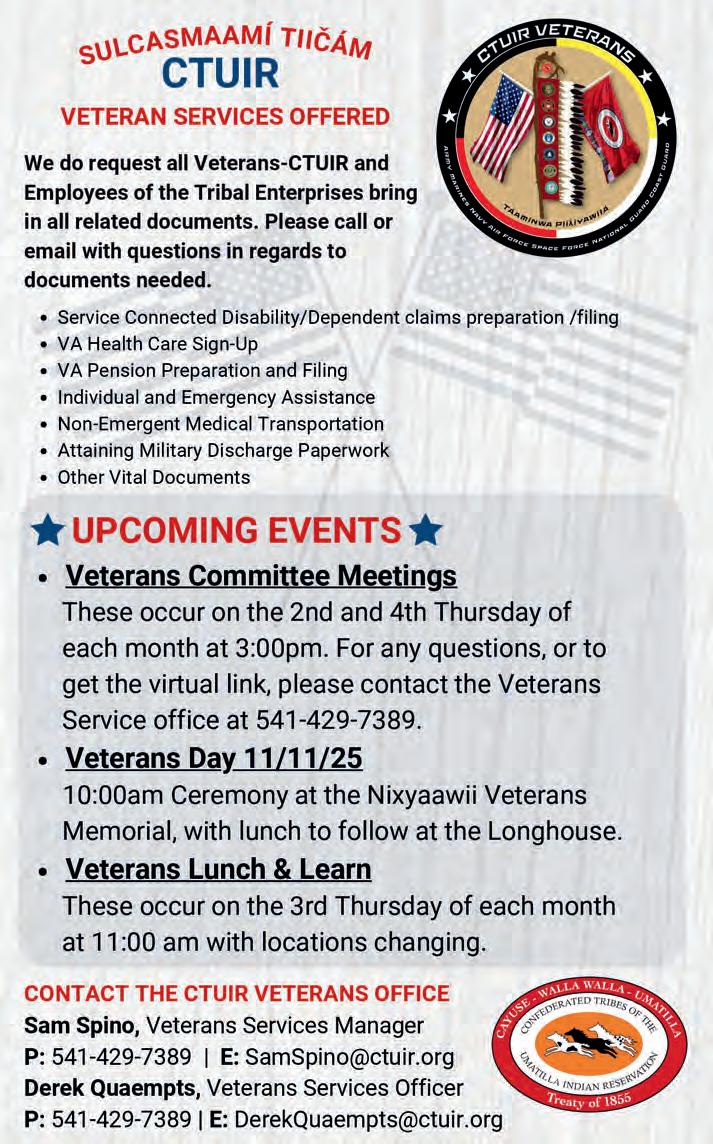
Pendleton Schools is launching an app called ParentSquare to make it easier for families, teachers and administrators to stay connected. LEE GAVIN/CTUIR
Breast cancer survivor Karen Malcom shares her story on Oct. 21 as past of Yellowhawk Tribal Health Center opening it mammography unit. YELLOWHAWK TRIBAL HEALTH CENTER
FAFSA enrollment open for 2026-27 school year
The agency opened the form up to the general public seeking higher education financial aid on Oct. 1.
SHAUNEEN MIRANDA
Oregon Capital Chronicle
WASHINGTON — The updated form to apply for federal student aid launched for all students on Oct. 1, U.S. Education Secretary Linda McMahon told congressional leaders recently.
The department began testing in early August for the 2026-27 Free Application for Federal Student Aid — better known as FAFSA — to address any bugs or technical issues before opening it up to everyone in the fall.
The agency signaled earlier this year that the form would open up to the general public by Oct. 1, the typical opening date for the annual form that’s now congressionally mandated.
The department noted that for the 2026-27 FAFSA, 2,435 forms were started, 1,372 were submitted and 1,347 had been processed, as of Aug. 25.
McMahon’s letter to lawmakers on Aug. 26 followed the botched rollout of the 2024-25 FAFSA, which

faced several highly publicized hiccups during then-President Joe Biden’s administration’s attempts to implement a makeover after Congress passed the FAFSA Simplification Act in 2020.
The rollout of the following 2025-26 form, still under the Biden administration, took a staggered approach that included several
DNR begins work on needed Forest Management Plan
Work on this plan began Oct. 1 and will run to Dec. 31, 2026, and will provide guidance and direction for forest land on the Umatilla Indian Reservation.
BY THE CUJ
The Department of Natural Resources (DNR), Range Agriculture and Forestry Program of the Confederated Tribes of the Umatilla Indian Reservation (CTUIR) is required to development a Forest Management Plan.
Work on this plan began Oct. 1 and will run to Dec. 31, 2026.
The intent of the Forest Management Plan is to provide guidance and direction for management of forest land on the Umatilla Indian Reservation (UIR) and all tribal-owned forest land outside of the UIR.
The goal of this planning process is to develop management actions that provide for healthy natural ecosystems, which support the First Foods Mission of protecting forested lands along with their stream habitat for the perpetual cultural, economic and sovereign benefit of the CTUIR.
DNR will use a three-step process to develop the Forest Management Plan.
First, DNR wants to identify community issues and concerns to be addressed in the Forest Management Plan.
DNR wants to hear from members of the CTUIR regarding any issues and concerns they have for the management of forest lands.
DNR also plans to meet with the Land Protection Planning Commission, Water Commission,
Fish and Wildlife Commission, Economic and Community Development Committee, Cultural Resources Committee and the Land Acquisition Committee in the next two months to hear their views on management of forest lands.
DNR will then develop goals and objectives that address these community derived issues and concerns.
Finally, DNR will identify alternatives for management of forest lands that meet the goals and objectives including any necessary change in management actions.
In making their recommendation for any change in management of forest lands to the Board of Trustees (BOT), DNR will consider the effects of the management alternatives on the cultural and natural resource values of the CTUIR.
The BOT and Umatilla Agency Superintendent will have the final decision on which management alternative will be implemented.
If you would like to express your views, including any concerns you feel must be addressed in the Forest Management Plan, please submit your written comments either by mail to Gordy Schumacher, Department of Natural Resources, CTUIR 46411 Timíne Way, Pendleton, OR 97801 or by email at GordySchumacher@ ctuir.org.
rounds of testing and gradually increased the number of people able to complete the form.
Though that form debuted earlier than the 2024-25 application, the full rollout still came nearly two months later than the usual Oct. 1 date.
“Under President Trump’s leadership, our team has
prioritized technical competence and expertise, which has led to the earliest testing launch of the FAFSA form in history,” McMahon said in a statement.
“The Biden Administration failed the FAFSA rollout two years ago, leaving millions of American students and families without clear answers or a path forward in their educational journey,” she said. “Congress gave us a mandate to improve the form and deliver it on time for students, families, and institutions of higher education — and I am proud to certify that the form will launch on time this fall.”
McMahon’s letter to the chairs and ranking members of the Senate Committee on Health, Education, Labor and Pensions and the House Committee on Education and Workforce follows a law signed by Biden last December that ensures the FAFSA rolls out by Oct. 1 each year.
The law also requires the Education secretary to notify Congress by Sept. 1 annually on whether the department will meet that Oct. 1 deadline.
To enroll or to renew your FAFSA application, visit https:// studentaid.gov/h/apply-for-aid/ fafsa. – oregoncapitalchronicle. com

The updated Free Application for Federal Student Aid for the 2026-2027 school year will launch for all students by Oct. 1, U.S. Education Secretary Linda McMahon said. GETTY IMAGES

Nixyáawii Community Financial Services (NCSF) recently announced it has been awarded a $100,000 U.S. Bank Foundation Opportunity Fund grant. FILE
NCFS awarded $100K U.S. Bank Foundation Opportunity grant
BY THE CUJ
PENDLETON – Nixyáawii Community Financial Services (NCSF), a nonprofit organization whose mission is to improve the financial well-being of individuals and families in the Umatilla Indian Reservation community through loans and development services, recently announced it has been awarded a $100,000 U.S. Bank Foundation Opportunity Fund grant.
The grant will be used to scale its Homeownership Services Program, which supports tribal members in achieving and sustaining homeownership. The program provides comprehensive support – homeownership counseling, down payment and site development assistance, financial coaching, and loan packaging.
“Creating opportunities for our community requires resources, and we appreciate the support from the U.S. Bank Foundation, which helps us continue to build and expand the innovative programs we’re proud to offer,” said Pamela Ranslam, NCFS Homeownership Services Manager.
NCFS is building a communitydriven system to support tribal citizens through every stage of homeownership.
This includes financial education, credit repair, home construction, and post-purchase support.
Its efforts aim to eliminate barriers to ownership, especially for low- to moderate-income (LMI) tribal members.
In addition, NCFS will soon begin construction of new homes on the Umatilla Reservation, giving tribal members the opportunity to purchase a new home.

“Safe and stable housing can help children, families and communities thrive. Supporting organizations like Nixyáawii Community Financial Services to help create pathways to homeownership for more people is an investment that can benefit generations to come,” said Meghan Valley, community affairs manager at U.S. Bank.
The U.S. Bank Foundation created the Opportunity Fund in 2023 to support organizations working to increase wealthbuilding opportunities for low- to moderate-income communities.
For more information about Nixyáawii Community Financial Services and its programs, visit www.nixyaawii-cdfi.org.
“Safe and stable housing can help children, families and communities thrive. Supporting organizations like Nixyáawii Community Financial Services to help create pathways to homeownership for more people is an investment that can benefit generations to come.”



Pamela Ranslam

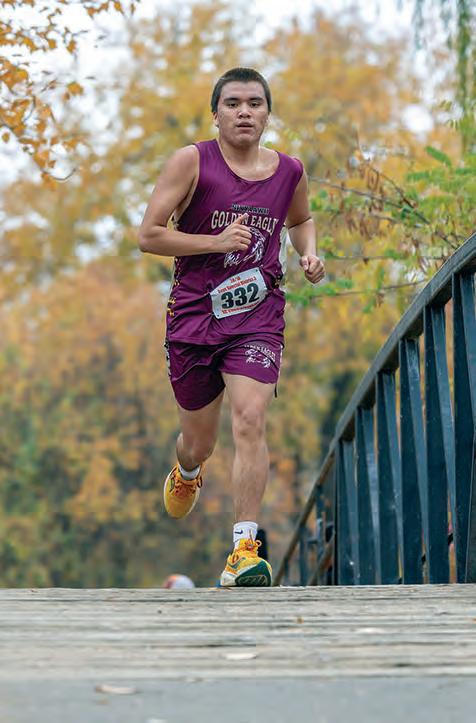
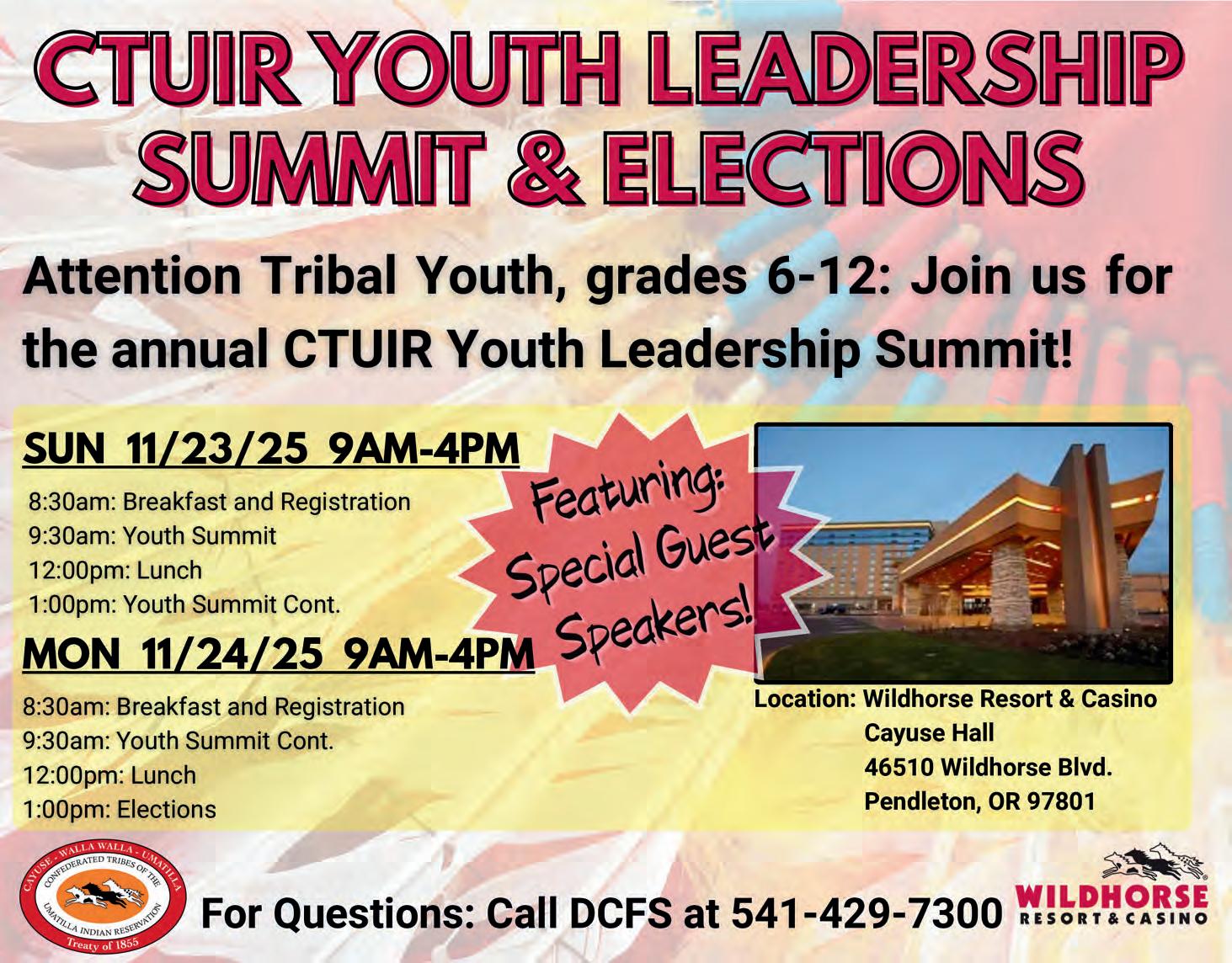
Abi Coy returns a shot over the net for Helix as her teammate Emily Pace watches. SARA PHINNEY
Nixyaawii's Cashis Beavis runs in the 1A/2A District 3 boys cross-country championships on Oct. 31 in Pendleton.

3rd annual TCOC Powwow set for Feb. 27-28, March 1
WIL PHINNEY
Special to the CUJ
The third edition of the threeday Two Cultures One Community Powwow (TCOC) is scheduled for Feb. 27, 28, and March 1, 2026, at the Pendleton Convention Center in Pendleton, Oregon.
Organizers are expecting at least as many dancers and drummers as last year, with an estimated 12,000 people coming to witness the action and visit vendors during the three-day competition. Last year more than 500 dancers and 15 drums competed and performed.
“We’re striving each year to make it better,” said Terri Carnes, secretary of the TCOC Pow-Wow Committee. “We are very excited to organize this event and we’re appreciative of people from the Pendleton area who have embraced our efforts.”
Drummers, singers, and dancers representing more than a dozen states from as far away as Minnesota and New Mexico, as well as from Canadian provinces, are expected to compete and participate. Dancers will range from tiny tots as young as age 3 to Golden Age men and women in their 80s and 90s. Some of the best fancy dancers will provide an energetic, sometimes frenetic, and colorful exhibition, while basket-hat-wearing ladies in their

heavy leather dresses, shiny with shells, keep a comforting motion around the Convention Center floor during the three-day event.
The dancers and big drums, from as far away as New Mexico and Alberta, Canada, compete for cash money. Three dance specials are being planned.
As envisioned, the pow-wow is designed to draw together the Native Community from the Confederated Tribes of the Umatilla Indian Reservation with the cowboy community from Pendleton.
But you don’t have to be a cowboy
to attend. Everyone is welcome and encouraged to attend one of the sessions, with the dance-offs and drum duels culminating with awards on Sunday evening.
The Two Cultures One Community Powwow gives the Pendleton community, as well as observers from around the region, the opportunity to see upclose Native American regalia, some of it decades old, and hear the powerful pounding of the big drum accompanied by as many as 10 singers at a drum. Big drum groups take turns singing songs for the different age groups and
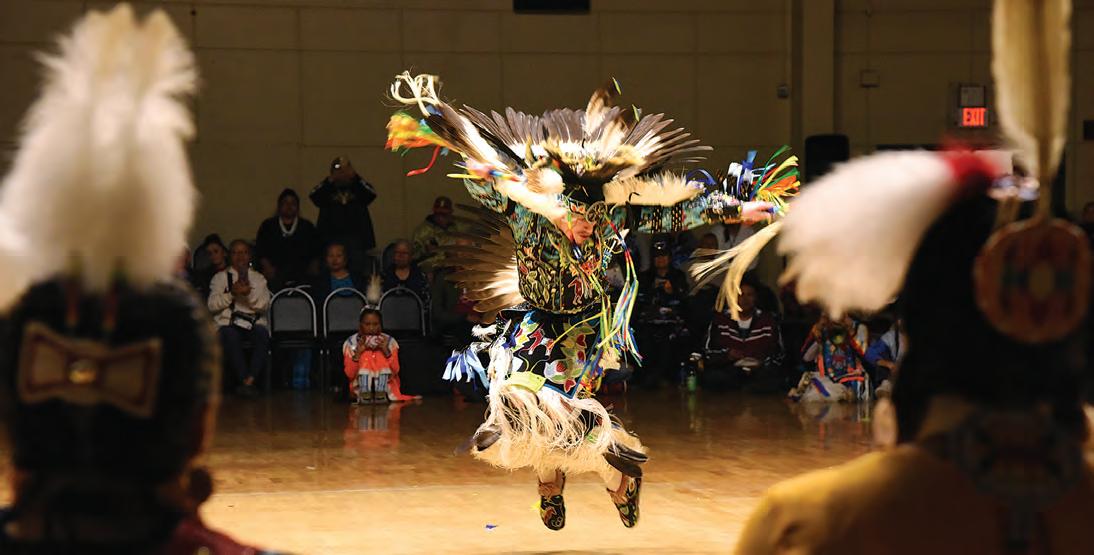
dance categories.
Additionally, the powwow spreads from the main convention center where the dancing and singing takes place, to two external rooms filled with more than three-dozen vendors, offering everything from coffee cups to turquoise jewelry to wallsized artwork. Last year, vendors included many local artisans, as well as those from as far away as Minnesota and Florida.
The original idea for the TCOC Powwow came from a conversation between Pat Beard, who manages the Pendleton Convention Center, and Fred Hill Sr., a CTUIR Language teacher and Longhouse Leader. Beard and Hill’s conversation led to the formation of the TCOC Committee comprised of CTUIR members and Pendleton residents. The Committee’s work resulted in the late-winter event designed to “create community and foster better relations between the City of Pendleton and the CTUIR,” according to Beard.
The TCOC Committee includes Pat Beard, Fred Hill Sr., Kara Woolsey, Terri Carnes, Melinda Broncheau, Daisy Minthorn, Sherri Round, Kaeleen McGuire, Lisa Ganuelas, and Wil Phinney.
Admission to the TCOC Powwow is $5 per session or $15 for the weekend, and tickets are available at the door. The Pendleton Convention Center is located at 1601 Westgate in Pendleton, Oregon.
Nixyáawii Community Financial Services, the CTUIR and City of Pendleton play major roles in the three-day production, but the event is organized by a volunteer committee that relies on sponsorships, grants, and contributions to make TCOC happen.
“We’re always thankful when someone steps up to help us financially,” said Phinney, a TCOC Committee member. “We are a non-profit doing good things, and we rely on others, who feel the same way, to help us out.”
To be an event sponsor, email twoculturesonecommunity@ gmail.com.
The three-day Two Cultures One Community Powwow is scheduled for Feb. 27 and 28, and March 1, 2026, at the Pendleton Convention Center in Pendleton, Oregon. PHOTOS BY WIL PHINNEY
Prevent falls, create safe mobility in home
MCKAY CREEK ASSISTED LIVING
Special to the CUJ
As we age, maintaining balance, strength, and mobility becomes increasingly important. For many elders, staying active and moving safely isn’t just about physical health—it’s a way to continue participating in cultural traditions, community gatherings, and daily life with independence and dignity. Falls are a leading cause of injury for older adults, but with awareness, planning, and small adjustments, they can often be prevented.
Understand the Risks
A fall can happen anywhere— at home, during community events, or while enjoying outdoor activities. Factors that increase the risk include decreased muscle strength, vision changes, medication side effects, uneven surfaces, and cluttered living spaces. Elders may also face hazards like uneven terrain at community gatherings, trails, or outdoor spaces. Recognizing these risks is the first step in prevention.
Practickal Steps for Home Safety
Creating a safe environment at home is key to reducing falls. Simple modifications can make a significant difference:
• Remove tripping hazards: Secure loose rugs, clear cluttered walkways, and organize cords out of walking paths.
• Improve lighting: Bright lights in hallways, bathrooms, and entryways can help elders see

obstacles clearly. Motion-sensor lights near doors and stairs are particularly helpful.
• Install supportive devices: Grab bars in bathrooms, handrails on both sides of stairways, and non-slip mats in showers provide essential support.
• Wear appropriate footwear: Shoes that fit well and provide traction help maintain balance, both indoors and outdoors.
Maintain Strength and Balance
Physical activity is one of the most effective ways to prevent falls. Some exercises that improve strength, flexibility, and balance include:
• Walking outdoors: Enjoy walkin trails, community grounds, or around homes while connecting with nature.
• Chair exercises and stretching: Gentle movements inspired by traditional dances or practices can maintain flexibility.
• Balance training: Simple activities like standing on one foot or stepping over low objects help maintain coordination and stability.
Regular exercise not only reduces the risk of falls but supports health, energy, and participation in community life.
Community Safety Considerations
Fall prevention extends beyond the home. Events often involve walking on uneven terrain, steps, or long outdoor distances. Safety strategies include:
• Using supportive canes or
CULTURAL INSTITUTE
AMERICAN VETERANS TRAVELING TRIBUTE
Vietnam Veterans Memorial replica wall
November 6-11
This tribute is an 80% size replica of the Vietnam Veterans Memorial wall located in Washington, DC. The wall, designed to honor our veterans who valiantly served and lost their lives in service, lists the names of the more than 58,000 service men and women who lost their lives during the Vietnam War.
•Tribute arrival with motorcycle escort the afternoon of Thursday, November 6.
•Tribute exhibit opens at 10am on Friday, November 7 Open 24 hrs daily. Free admission.
walking sticks when necessary.
• Encouraging elders to attend events with a companion or family member.
• Choosing well-lit paths and avoiding areas with obstacles or slippery surfaces.
• Wearing footwear suitable for outdoor conditions.
Community programs that focus on elder wellness can also provide resources, education, and opportunities for group exercises that strengthen mobility while fostering social connections.
Recognizing When to Seek Help

Even with careful precautions, falls can occur. Prompt attention to any fall-related injuries is crucial. Medical evaluation ensures appropriate treatment and prevents complications. Additionally, consulting with physical therapists or elder care specialists can create personalized fall-prevention plans tailored to an elder’s abilities and lifestyle.
Fall prevention isn’t about limiting activity—it’s about empowering elders to move safely and confidently while remaining connected to their cultural practices and community roles.
At McKay Creek Assisted Living, we understand the importance of safety, independence, and cultural connection. Our community offers designed living spaces, mobility support, wellness programs, and engaging activities while promoting safe, active living.
Visit McKayCreekAL.com or call 541-612-8213.


www.pendletonfurniturelady.com


November
Learn how Tule Mats are made from our local experts! Free admission. Drop in any time. All ages are welcome. Complimentary refreshments!
FREE ADMISSION FOR VETERANS!
November 1-29
In appreciation for your service, we are inviting all U.S. Military Veterans to visit Tamástslikt exhibits free of charge during the month of November. View the exhibits, shop the Museum Store, enjoy lunch at Kinship Café. We are grateful for your service and look forward to greeting you!
St. Anthony Hospital presents PRIDE IN PATRIOTISM: FROM THE FRED L. MITCHELL COLLECTION
Exhibit ends December 6
Don’t miss your last chance to view this vast exhibit of patriotic beadwork from the Fred L. Mitchell Collection. Brilliant colors, extraordinary expertise, and heartfelt messaging demonstrate the commitment of tribal people to support our country.
THANKSGIVING THANK YOU SALE!
November 11-15
In appreciation for our top supporters and partners over the past year, all Inwai Circle of Friends members, CTUIR tribal members, and CTUIR employees will receive 30% o your purchases for one week only. We want to thank you for your support and help you get a headstart on your holiday shopping!
FREE FIRST FRIDAY!
FREE admission all day at Tamástslikt Cultural Institute.
November 7 10am-5pm
Dine inside at Kinship Cafe or order take-out. Enjoy Indian Tacos ($10.50) and Frybread ($5) from 11am-2pm. Shop the Museum Store for unique and exclusive products. Visit our colorful beadwork exhibit, Pride in Patriotism: From the Fred L. Mitchell Collection of Patriot Beadwork.
How senior citizens can winter-proof their homes
MCKAY CREEK ASSISTED LIVING
Special to the CUJ
Do you keep your home ready for visitors at all times? Because whether you like it or not, Old Man Winter is coming.
If you’re an older adult living independently, it’s important to make sure your home is winterready in case inclement weather hits. From having enough food and supplies on hand in case the weather keeps you confined to your house for a few days, to proactive measures to ensure the home’s integrity during bad weather, we have some tips and advice for getting through the winter unscathed.
Heat Check
When it comes to your physical health, it’s always recommended you see a physician before a problem arises.
Those preventative measures extend to your home. Schedule a technician to come out to inspect and clean your furnace before it breaks down at the worst possible time. They might find parts at the end of their lifespan that could cause your furnace to go out at the worst possible time.
If you wait until it goes out in especially bad weather, there will likely be many other people in the same predicament, meaning it’ll take longer to get on a technician’s schedule.
Staying Safe Outside OK, the snow has fallen, you’re going a bit stir crazy and you want


to get out of the house. That’s going to mean shoveling snow, but for older adults, that can be a hazard.
Shoveling snow requires a tremendous amount of exertion, which can add to heart risks the cold already poses to older adults.
According to the American Heart Association, “People with coronary heart disease often suffer angina pectoris (chest pain or discomfort) when they're in cold weather.”
The AHA goes on to add, “Elderly people may also have lower subcutaneous fat and a diminished ability to sense temperature so they can suffer hypothermia without knowing they're in danger.”
So if you have some teenagers in your neighborhood, maybe they want to make a few bucks
NOVEMBER

shoveling your driveway and sidewalk for you.
If you do go out in snow and ice weather, slipping and falling becomes a real possibility. You can buy shoe coverings with spikes to help you with traction to reduce the changes of falling.
Keep The Cold Out
Along with keeping yourself safe outside, there are measures you should take to protect your home from the elements.
Faucet covers: They cost just a few dollars at any hardware store, making faucet covers among the cheapest and easiest ways to protect your home from freezing temperatures. Just slip them over hose nozzles and other outdoor faucets and it can prevent water from freezing in your pipes.

Have your gutters cleaned: We don’t recommend that you get up on a ladder yourself, but hire a local company to clean your gutters before debris freezes and causes water backups in your home.
Keep your balance: Check that any outdoor handrails or steps aren’t loose. Those can be a hazard at any time, but it becomes much more dangerous when the ground is icy.
Winter Checklist
To prepare yourself for winter weather, it’s recommended you keep the following in your home:
•Enough food to last you 4-5 days in case bad weather makes it difficult to leave the house
•Fully stocked medications
•Winter jacket, sweatshirts, mittens, warm socks, and other clothes suitable for bad weather
•Extra blankets
•Flashlight, with extra batteries on hand
•Tools
•Snow shovel, kitty litter, de-icer (but as noted above, if you can outsource that job, do so)
•First aid kit
•Phone numbers for local emergency services
You can beat the winter chill next to the fireplace in our lobby while you spend time with your friends and neighbors, and we prepare hot, delicious meals to bring comfort in winter.
For more information visit mckaycreekal.com, or call 541276-1987.
Celebrations

Birthdays:
4th: Juanita Hussey and Aiyanna
Thompson Red Elk ~ also VOTE day!
5th: Brigham Campell and Seraya Lueders Jones
9th: CJ Medellin
13th: Katrina Derrick and Vicki LaCourse
17th: Midnight Rose Tewawina
18th: Danny Bing
23rd: Eli Kash Kash
24th: Kieran Brigham and Sharice Male
26th: James Campbell
27th: Diane Samson
27th: Tysen Minthorn
28th: Ryan Marsh
30th: Kyra Metcalf
Anniversaries:
5th: Tracy & Val Viegener
11th: Charlie & Dennis Quaempts
17th: Sharice & James Male





If you’re an older adult living independently, it’s important to make sure your home is winter-ready in case inclement weather hits. MCKAY CREEK ASSISTED LIVING/COURTESY
How NASA satellites help researchers better understand Northwest river temperatures
When waters get too warm, they can harm or even kill salmon. The problem is expected to get worse as the climate continues to change.
COURTNEY FLATT
Northwest Public Broadcasting
When waters get too warm, they can harm or even kill salmon. The problem is expected to get worse as the climate continues to change.
Now, researchers are using data from NASA satellites to help.
Using satellite remote sensing to measure water temperature has been heavily underutilized, said Faisal Hossain, a professor at the University of Washington Department of Civil Environmental Engineering. He said that’s often because there’s a lack of access to the data or an easy way to package it.
Now, UW graduate student George Darkwah is changing that. Darkwah developed an opensource tool and website, called Thermal History of Regulated Rivers, or THORR.
THORR uses artificial intelligence to interpret all that temperature data from NASA’s Landsat satellites, dating back decades. It allows people to better understand river temperatures over time, Darkwah said.


“The idea is to utilize this untapped data on not just our (water) management techniques, but on very diverse areas within the environmental ecosystem here on Earth,” Darkwah said.
Without THORR converting the data to something usable, the results could be patchy, Hossain said. There could be clouds. Rivers are narrow. That makes it hard for the satellite to see.
“When (the satellite) was first launched, land surface was the focus, not really water. … You run into all kinds of complications,” he said.
THORR helps fill those gaps, giving a comprehensive account of river temperatures, Hossain said.
“(Darkwah’s) work has extended the value of Landsat beyond land to water on the land,” he said.

However, the high-tech isn’t replacing the old. Darkwah said he views it as a complement to traditional, on-site water temperature gauges.
“It can also be applied or extended to areas that do not even have existing water temperature measurements,” Darkwah said.
Like in his home country of Ghana. Darkwah said he was surprised at the amount of scientific data available here in the United States.
“I’m like baffled about the amount of data, but then to be able to also use it in a country like mine where there isn’t any data for me to rely on (could be helpful),” Darkwah said.
The satellite data he’s using covers the entire world, giving the tool a global reach, he said.
But Darkwah said he didn’t want
THORR to be stuck in the dusty halls of academia. He designed it so that people developing river policies or management strategies could easily use the information “for the benefit of everyone.”
“Based on that knowledge, we can modify how we operate water in the future,” Darkwah said.
While developing the tool, he worked with the Columbia River Inter-Tribal Fish Commission, or CRITFC, to fact check the onthe-ground data and THORR’s usability. In a news release, CRITFC leaders said the tool could be used to help manage salmon.
“It’s imperative that we understand what’s happening in the Columbia River, the water temperature, because the fish have lethal limits,” said Elaine Harvey, CRITFC’s watershed department manager, in the news release.
British Columbia has also expressed interest in the tool, Hossain said.
There are lots of ways to use THORR, the researchers said. They hope it could help inform managers of the best times to release or spill water over the tops of dams to help fish.
In addition, it could help look for patterns, like with cyanobacteria blooms, commonly known as algal blooms, or temperature fluctuations near data centers, Darkwah said.

FALL


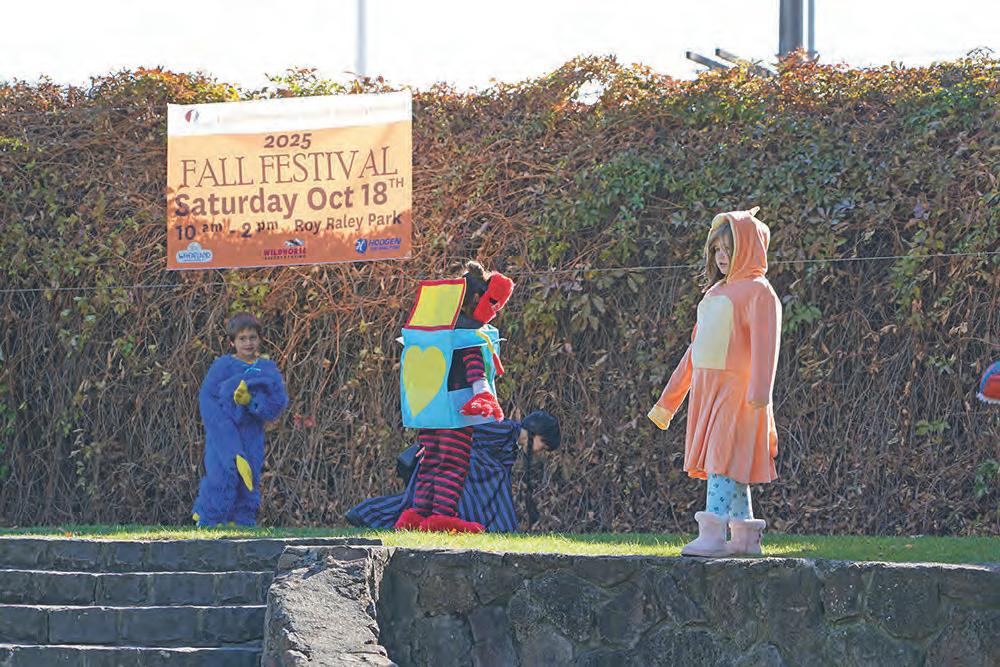

Sockeye slamon like these are among the salmon species in peril in hot water.
AARONKUNZ /OREGON PUBLIC BROADCASTING
Trunk or Treat Mission longhouse Oct. 29, 2025




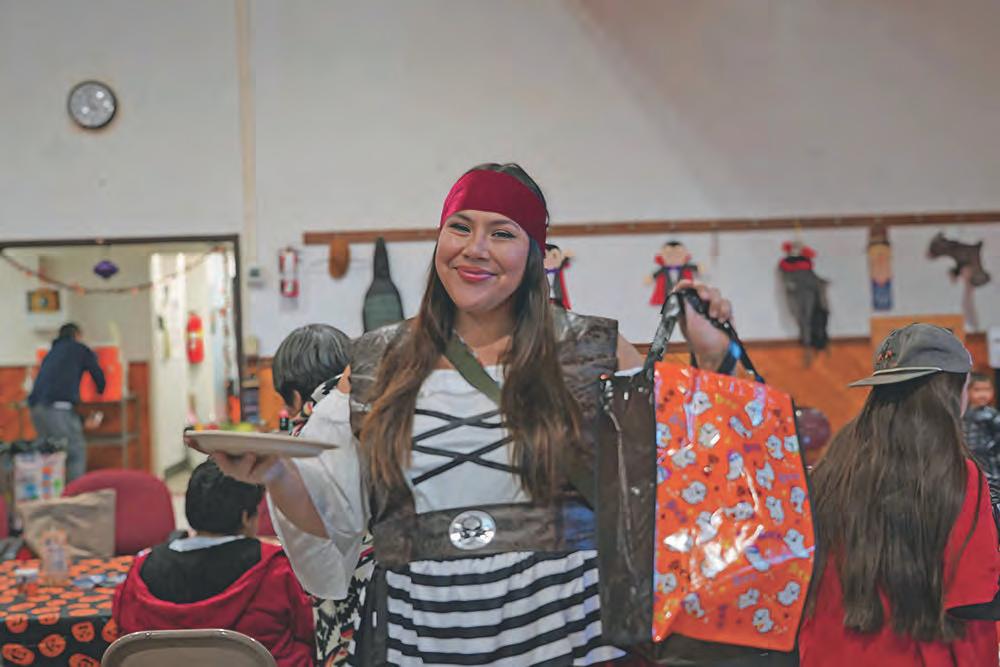


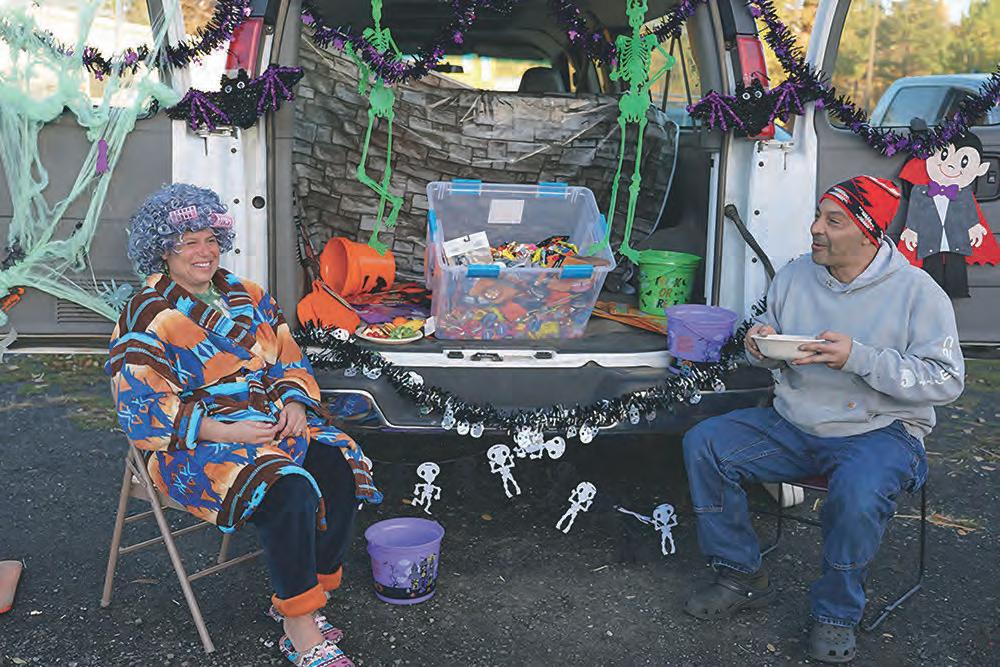
NW tribes could lose millions in U.S. funds
MELANIE HENSHAW
Investigatewest
PORTLAND – A report from Portland State University (PSU) found that budget cuts under President Donald Trump’s new spending bill threaten nearly half of federal funding allocated to federally recognized Native American and Alaska Native nations in 2024.
Roughly $530 million of the $1.19 billion allocated to Northwest tribal nations in fiscal year 2024 — used to fulfill the federal government’s trust and treaty obligations to Native American and Alaska Native tribes — is at risk of being cut. The congressionally allocated funds serve functions for tribes in the Northwest, including providing clean drinking water, affordable housing, schools, transit and land management. Funding is decided by Congress yearly and can be disbursed over a period of time that exceeds the calendar year it is allocated.
“All across the board tribes are worried about the funding cuts that are happening right now,” said Serina Fast Horse, who is Lakota and Blackfeet and serves as the co-director of the Northwest Environmental Justice Center, which provides grant application help and advising to Indigenous communities in the Northwest.
Fast Horse said there are concerns among Northwest tribes about further cuts to vital programs ranging from health and wellness to early childhood education. The report warns of vulnerabilities to programs and grants tribes rely on for resilience in the face of climate change, like improving home weatherization, managing forestland and renovating aging homes. Federal dollars to help Northwest tribes bolster their infrastructure against the increasing threats from wildfire, drought and sea-level rise could also be slashed.
The PSU report found millions in Clean Air Act funding could also go away — the Environmental Protection Agency earmarked nearly $2 million in 2024 for Northwest tribes in a series of grants for monitoring air quality and pollution. Much of the allocated funding has yet to be distributed to tribes and is now at risk of being cut altogether.
The report demonstrates how reductions across, including at the EPA, the Department of the Interior and the National Oceanic and Atmospheric Association, could reverberate across Indian Country.
Tribal officials shared concerns that drastic cuts could cause the federal government to fall short of trust and treaty obligations that mandate the federal government support tribal services, uphold tribal sovereignty and protect tribal treaty resources — responsibilities that courts, including the U.S. Supreme Court, have upheld.
“All the funding reductions addressing clean water, air and dealing with climate change have impacts on the tribes’ culture and treaty protected resources,” said William E. Ray Jr., chair of the
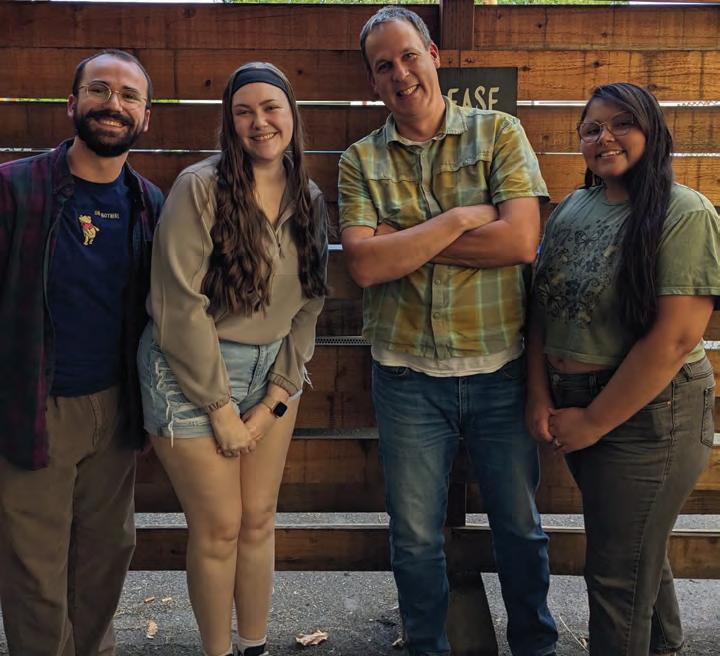
Klamath Tribes.
Researchers declined to disclose specific projects at risk of elimination for fear of retaliation, and a number of tribes and tribal organizations declined to comment to InvestigateWest, citing similar concerns.
“Trump and Congressional Republicans are wreaking havoc on tribal communities with their ‘Big, Ugly BETRAYAL’ of a law that arbitrarily cuts many programs supporting folks in Indian Country, where chronic underfunding is already impacting services and exacerbating disparities,” said Oregon Sen. Jeff Merkley.
He added the federal government plays an outsized role in funding essential services to tribal communities, including health care, education and public safety, and that the Inflation Reduction Act took important steps in advancing funding for water infrastructure and environmental programs for tribes.
In 2024, Clean Air Act related funds were used to fund 15 projects for 12 Northwest tribes.
The Confederated Tribes and Bands of the Yakama Nation, the Confederated Tribes of the Umatilla Indian Reservation and the Tulalip Tribes are some of the Native American nations set to receive research grants for improving air quality and pollution monitoring. Among 12 tribes selected for funding, several of them focus on minimizing exposure to poor air quality and harmful pollutants to their elderly and medically vulnerable residents. Other tribes intend to study impacts of pollutants on important First Foods — culturally significant staple foods consumed before colonization — that officials say are critical to improving health outcomes for their citizens.
Researchers at PSU examined 469 programs impacted by President Trump’s reversal of former President Joe Biden’s Executive Order 14008, which sought to address climate change and created a number of
compared to population figures. In 2024, Native American tribes received just 1.7% of federal energy and environment spending, despite Native people making up 2.9% of the U.S. population.
Between 2010 and 2024, tribes within the bounds of Idaho, Washington and Oregon received roughly $2.81 billion in federal investments in energy and environmental infrastructure, which represents roughly 14% of the $20 billion in allocations made to tribes nationwide.
The researchers determined that programs funded under the Inflation Reduction Act, Biden’s 2022 climate, health and tax law, are at particular risk of being eliminated. The funding allocated to tribes under the IRA represented a historic investment in infrastructure in Indian Country, more than doubling energy and infrastructure investment from $1.51 billion nationwide to $3.94 billion in 2024, around .04% of total federal grant spending obligations for 2024.
environmental justice initiatives. Sixty of the programs identified by researchers were specifically named in the Republican-led spending bill for cuts, and 17 of those provided funding directly to tribes. The programs accounted for roughly 35% of all federal investments in tribes in 2024. The report says not all of the funding will be cut, but a significant portion of it could be.
The cuts come at a time when Native Americans and Alaska Natives already have limited access to federal services and funds, according to a December 2024 report from the U.S. Government Accountability Office, a nonpartisan watchdog. It found when tribes had to compete with other entities for federal funding, they may receive a small portion of the total amount, and that limited access to federal services and funds contributes to known disparities for Native Americans and Alaska Natives compared to other Americans.
Of the $20.15 billion in federal funding that went to tribes between 2010 and 2024, tribes within Idaho received $304.56 million, Washington tribes $1.81 billion, Oregon tribes $690.76 million, and Alaska Native tribes received $2.35 billion.
Other programs at risk of being cut include the EPA’s embattled Environmental Justice Government-to-Government Program, which funded initiatives by states, tribes and local governments to support activities that lead to environmental or public health impacts.
Under that program, in 2023, the EPA awarded the Tulalip Tribes $977,000 to work in conjunction with the Yakama Nation to create a tool to detect which homes are at greatest risk from wildfire smoke infiltration and dangerously hot weather, which are growing issues affecting both communities.
While the federal government has repeatedly affirmed its obligations to tribes, actual allocations remain disproportionately small
“When you put them in the context of how much money the federal government actually spends on certain things, it’s pennies on the dollar,” said Sophie Lalande, a co-author of the PSU report.
Soon after taking office and without consulting Congress, the Trump administration suspended some grants that tribal communities used heavily, such as community change grants, distributed by the EPA’s Offices of Environmental Justice and of External Civil Rights Compliance during the Biden administration, to support climate resilience and clean energy. Distributed as a part of the Inflation Reduction Act, the grants were suspended as part of the Trump administration’s antidiversity, equity and inclusion efforts.
The grants helped tribal communities in the Northwest tremendously, said Fast Horse.
“They were providing hundreds of thousands of dollars to communities for infrastructure improvements, like access to clean drinking water and climate resilience hubs, just really essential pieces of community development for health and safety of communities,” she said.
The report stresses a multiplier effect from investments made in tribal communities. Infrastructure dollars invested on tribal lands often serve as anchors for broader local development, since tribal lands often share regional infrastructure like power grids, roads or water systems with nonNative communities, with the power of dollars rippling outward into surrounding rural towns and cities.
Bobby Cochran, a researcher with PSU and senior project manager at the National Policy Consensus Center, co-authored the report.
“We just haven’t made a major investment in infrastructure since the ’60s or ’70s, so this wasn’t fluffy,” he said. “It’s really important stuff that was just trying to play catch-up.”
Portland State University researchers found that many programs funded under the Inflation Reduction Act are at risk of being eliminated. Left to right are PSU researchers Justin Huber, Sophie Lalande, Bobby Cochran and Serina Fast Horse.
BOBBY COCHRAN

Essential facts about emergency alerts in Oregon
KRISTIAN FODEN-VENCIL
Oregon Public Broadcasting
PORTLAND – Emergency alerts can play a critical role in keeping people safe from natural disasters and other dire situations. In the era of smartphones, text alerts can be a speedy way to stay safe from earthquakes, tsunamis, wildfires and flooding.
What may not be apparent to people receiving alerts is that Oregonians have access to two emergency systems in the state. Here are the differences between those systems and their roles in public safety.
State System
The first emergency alert system available to Oregonians, which Multnomah County tested Aug. 14, is an opt-in system called ORAlert. Erin Zysett, a spokesperson for the Oregon Department of Emergency Management, said users go online and submit a phone number, zip code and other location information for OR-Alert.
“One of the challenges of the ORAlert system is that it is an opt-in system,” Zysett said. “So you need to go and you need to sign up for those.”
Zysett said the system asks for a zip code so people only get alerts for things happening in their area. In general, she said, people don’t want a tsunami warning if they’re in the high desert of Central Oregon.
“There is something called alert fatigue,” Zysett said. “We walk a fine line to making sure we’re getting you actionable information: the right information, to the right people, at the right time.”
If people get overwhelmed with alerts, Zysett said, they may start ignoring them.
Federal Alert System
The second emergency warning system in Oregon is the federal Wireless Emergency Alert (WEA) system. Unlike the OR-Alert system, users don’t have to opt in. It’s automatic. Anyone who has ever received an Amber Alert for a missing person case probably received it via the federal system. The service is free and sends alerts based on the region in which a cell phone is located.
But some people may have turned the alerts off without realizing. Zysett recommended

turning those on if you’re not receiving them.
The Federal Emergency Management Agency offers a guide on common issues that may prevent WEA alerts from reaching smartphone users.
Unlike the OR-Alert system, which is based on zip code locations, the federal system is linked to the GPS location of a phone. This makes it a good option for traveling.
Zysett said if you’re vacationing on the Oregon coast, for example, you’ll get a tsunami warning from the National Weather Service, but you may not receive all localized alerts through OR-Alert.
“I will emphasize that if it were a big enough event, you would get a Wireless Emergency Alert,” Zysett said.
Having a Plan B
It’s a good idea to have a backup plan when thinking about emergency alerts. While these warnings can protect Oregonians, the events they are warning about may actually prevent you from receiving an alert.
Earthquakes, tsunamis and wildfires can damage cellular towers and damaged towers won’t issue alerts.
Zysett recommends signing up for additional alerts via email at OR-Alert. Emails are accessible from computers everywhere.

Another option for receiving alerts is a NOAA weather radio. It tunes into a national hazard alert system that uses radio waves to warn listeners of major events.
The radios sit quietly until there’s an alert and then provide information on earthquakes, tsunamis and wildfires as well as the weather.


The federal Emergency Alert System also uses broadcast signals for radio and television, like those provided by OPB, to warn people in urgent situations. How do I sign up?
Users of OR-Alert can sign up by going online and filling in their phone number, zip code and other information.
Users of the federal Wireless Emergency Alert system are automatically signed up via their cellphones. Emergency Alert Systems will also appear on broadcast networks without additional sign-up requirements.

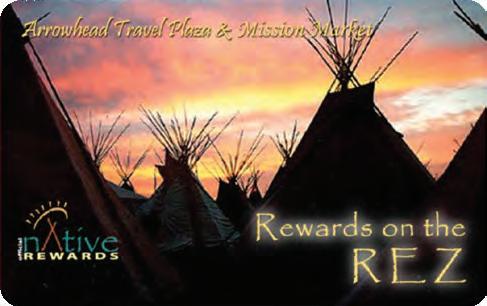
Multnomah County tested its emergency alert system earelier this year. Oregon has two systems, OR-Alert and the federal Wireless Emergency Alert system. APRIL EHRLICH/OREGON PUBLIC BROADCASTING

















































CTUIR Notice to Purchase
Umatilla Enrolled Members: CTUIR will exercise its Option to Purchase the land interests in the estate listed below, pursuant to the CTUIR Inheritance Code. CTUIR’s Option to Purchase is subject to Section 1.05(e) Tribal Member Right to Purchase.
Corrected Notice to Purchase*
In the Matter of the Estate of: Melanie Ellenwood
Probate No: T000186273
Identification No: 182U000398
CTUIR Inheritance Code Section 1.05(E) – Tribal Member Right to Purchase:
Eligibility Requirements: Any member of the Confederated Tribes owning an interest in trust land parcel where the Confederated Tribes has �iled a Notice to Purchase pursuant to Sections 1.05(D)(2), (3) and/or (5) of the Code may purchase such lands in the place of the Confederated Tribes if:
a) The member of the Confederated Tribes owns an interest in the subject trust parcel on the date of death of the decedent;
b) The eligible member of the Confederated Tribes �iles his/her notice of intent to purchase the interest in the subject trust parcel with the Secretary of the Board of Trustees within 30 days after publication of the purchase by the Confederated tribes in the Tribal newspaper; and
c) The eligible member of the Confederated Tribes’ right to purchase under this subsection shall be subject to the requirements that the fair market value of the interest in trust lands as determined by the Secretary [of the Interior] must be paid as et forth in section 1.05(C)(4) of [the] Code, and shall be subject to the rights of the surviving spouse and Indian lineal descendants set forth in section 1.05(C)(2), (3) and (7).
d) The eligible member of the Confederated tribes deposit payment in the amount equal to the fair market value of the subject trust parcel or interests therein, with the BIA Umatilla Agency Superintendent which payment shall be accompanied by the identi�ication of the decedent, the probate case number and trust parcel in questions. The eligible member must make the full payment for the subject trust parcel, or interest within 60 days of �iling its notice of intent to purchase. In such an event, the eligible member shall be authorized to acquire the interest in the subject parcel in the place of the Confederated Tribes.
Tribe: Nez Perce
Umatilla Enrolled Members: CTUIR will exercise its Option to Purchase the land interests in the estate listed below, pursuant to the CTUIR Inheritance Code. CTUIR’s Option to Purchase is subject to Section 1.05(e) Tribal Member Right to Purchase.
In the Matter of the Estate
No: T000151817
$ 104,925.06
CTUIR Inheritance Code Section 1.05(E) – Tribal Member Right to Purchase:
Eligibility Requirements: Any member of the Confederated Tribes owning an interest in trust land parcel where the Confederated Tribes has �iled a Notice to Purchase pursuant to Sections 1.05(D)(2), (3) and/or (5) of the Code may purchase such lands in the place of the Confederated Tribes if:
a) The member of the Confederated Tribes owns an interest in the subject trust parcel on the date of death of the decedent;
b) The eligible member of the Confederated Tribes �iles his/her notice of intent to purchase the interest in the subject trust parcel with the Secretary of the Board of Trustees within 30 days after publication of the purchase by the Confederated tribes in the Tribal newspaper; and
c) The eligible member of the Confederated Tribes’ right to purchase under this subsection shall be subject to the requirements that the fair market value of the interest in trust lands as determined by the Secretary [of the Interior] must be paid as et forth in section 1.05(C)(4) of [the] Code, and shall be subject to the rights of the surviving spouse and Indian lineal descendants set forth in section 1.05(C)(2), (3) and (7).
d) The eligible member of the Confederated tribes deposit payment in the amount equal to the fair market value of the subject trust parcel or interests therein, with the BIA Umatilla Agency Superintendent which payment shall be accompanied by the identi�ication of the decedent, the probate case number and trust parcel in questions. The eligible member must make the full payment for the subject trust parcel, or interest within 60 days of �iling its notice of intent to purchase. In such an event, the eligible member shall be authorized to acquire the interest in the subject parcel in the place of the Confederated Tribes.
